
Admin
-
Posts
7,469 -
Joined
-
Last visited
Content Type
Profiles
Forums
Events
Store
Gallery
Community Map
Posts posted by Admin
-
-
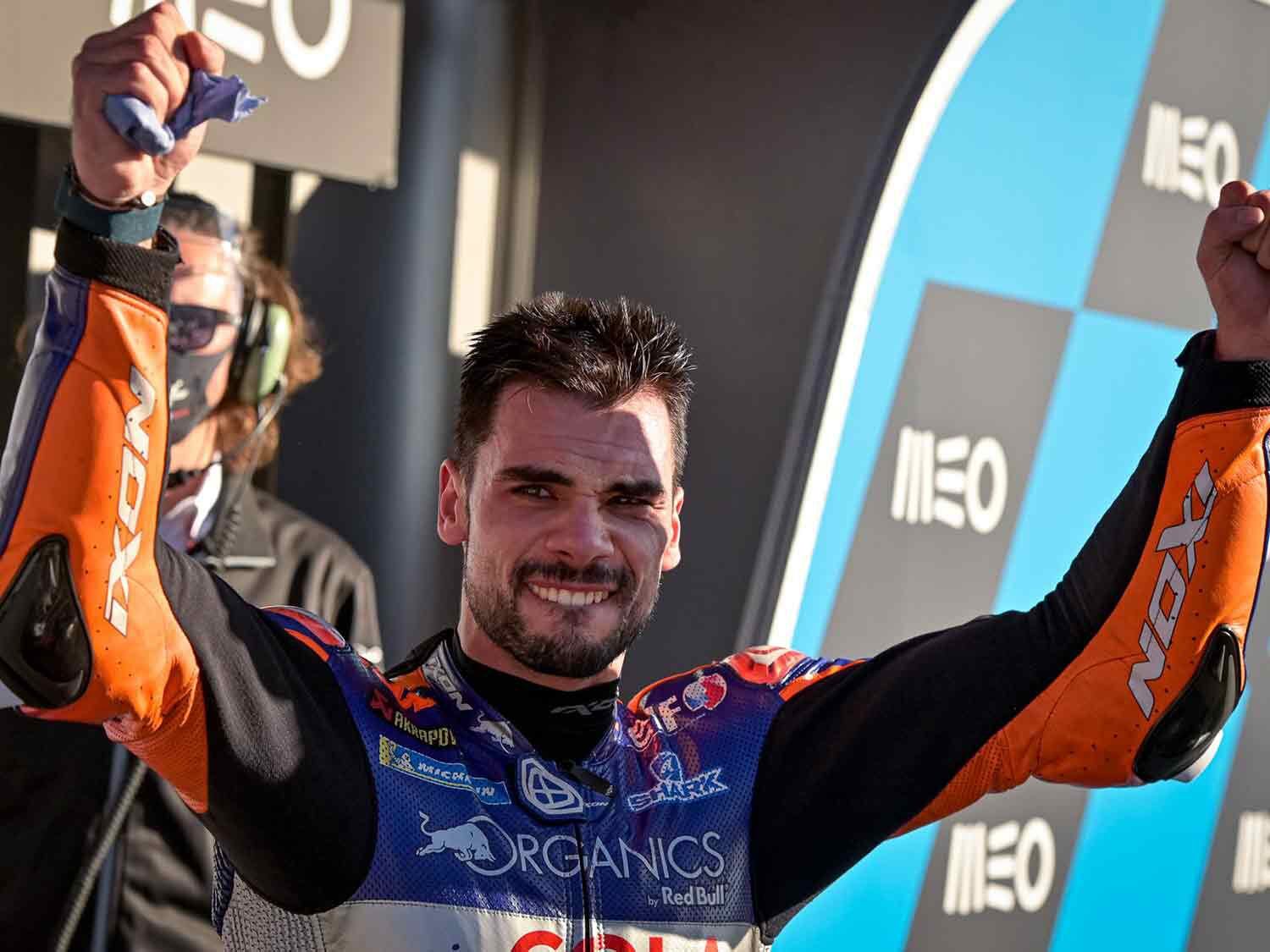
Miguel Oliveira took the win at Portimão. (MotoGP/) The top three finishers in the season-ending MotoGP of Portimão, Portugal, were all on satellite bikes—Miguel Oliveira topped the podium on a Tech3 KTM, Jack Miller on a Pramac Ducati, and Franco Morbidelli third on a Petronas Yamaha. All this year it has seemed that satellite teams have hit it right more often than the factory groups.
With Suzuki’s Joan Mir taking the 2020 MotoGP championship last weekend at Valencia 2, all that remained was the question of who could find a working combination for Portimão, a circuit new to the MotoGP paddock. Its ups and downs caused some riders to liken it to motocross, and another to find closest similarity to Laguna Seca, in Monterey, California. Although recently repaved, evidently presenting an abrasive surface that ages tires rapidly, both Andrea Dovizioso and Danilo Petrucci (both on Ducati) noted that bumps and “holes” remained numerous.
As so often, Maverick Viñales, the man of two moods, greeted Friday saying, “It’s been a long time since I enjoyed myself like this on the bike.” Oliviera topped FP1, saying, “I’m feeling really good and enjoying every moment on track, happy with every lap.” Miller, after qualifying third behind Oliveira and Morbidelli, would say, “I have been feeling good from the beginning.”
There had previously been a Portimão test in which MotoGP regulars were allowed to learn the circuit, but only on production bikes. On Saturday morning, Viñales’ fortunes nosed over as so often before: “…today we didn’t have the same feeling, especially when it comes to rear grip.
“Saturday was a disaster.” This has been Viñales’ oscillating trajectory so often in his career—the Fates smile upon him, only to deceive.
Yet in that same session, Miller and Oliveira remained strong as 1-2. Petrucci, starting a lowly 18th on a Ducati team bike, was finding hard going with his factory Ducati: “I…still can’t get a good feeling with the bike on this track.”
He described the production bikes they rode in the test as, “…softer and more flexible bikes, and that helps a lot. MotoGP bikes are made to go very fast but here there are bumps and ups and downs.”
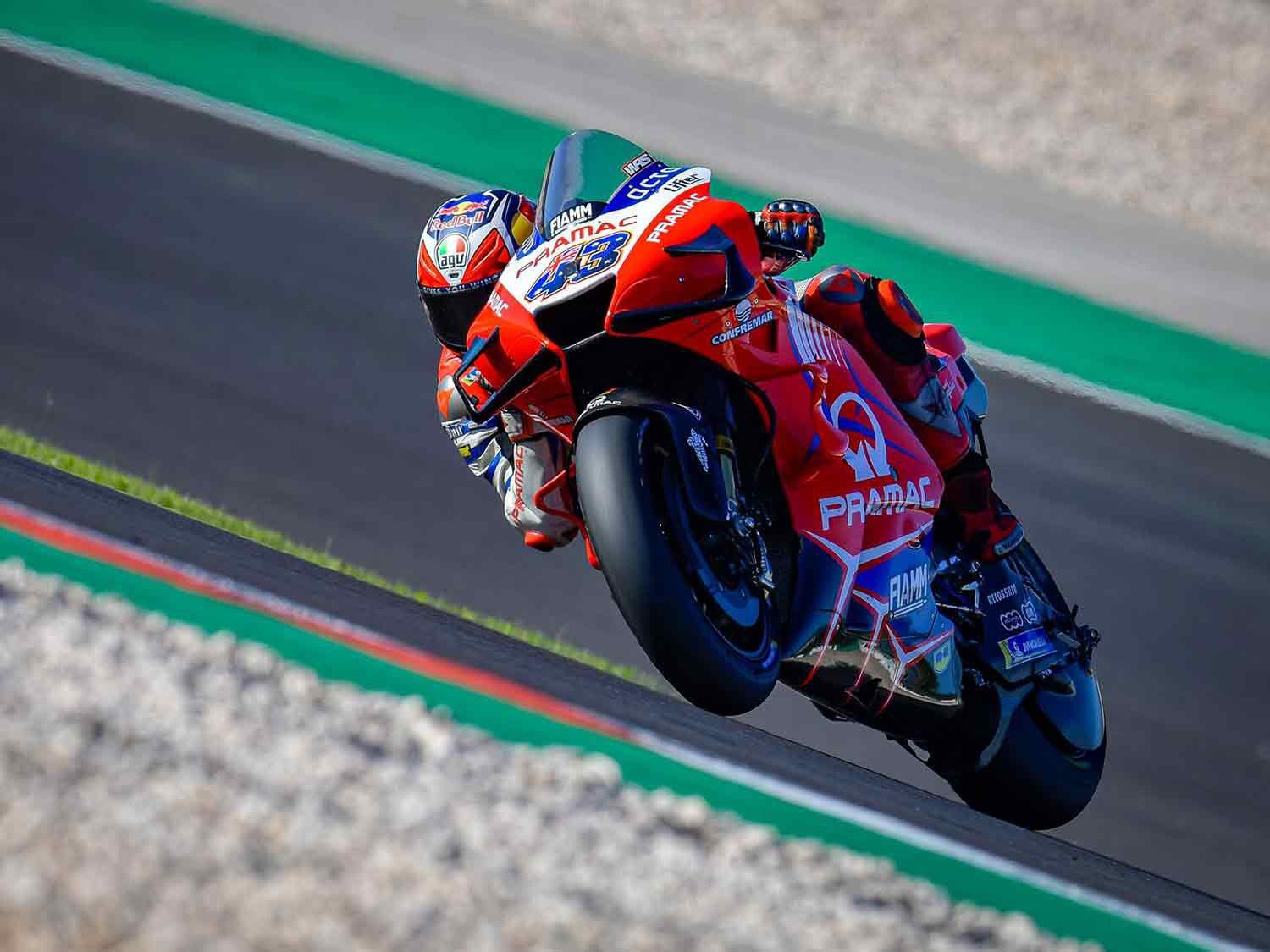
Jack Miller finished second in Portimão, but was nearly 5 seconds behind Oliveira. (MotoGP/) Years before, Ben Spies’ crew chief Tom Houseworth had described MotoGP bikes and their tires as being much stiffer than their World Superbike equivalents. Where there are bumps, that is a recipe for what MXers call “air time.” Tires generate zip for grip up above the pavement.
This put me in mind of things said about dirt-track car chassis setup. Yes, you can stiffen up the chassis like on an F1 car, but if you do, the suspension has to be exactly right or it doesn’t work at all. That is because the suspension must do the whole job. But with a more flexible chassis you get something that can work pretty well even if everything is a little off, because accidental chassis flex can compensate to a degree for an imperfect suspension setting. Could it be that MotoGP bikes are in general too specialized, too dependent upon a high level of pavement smoothness?
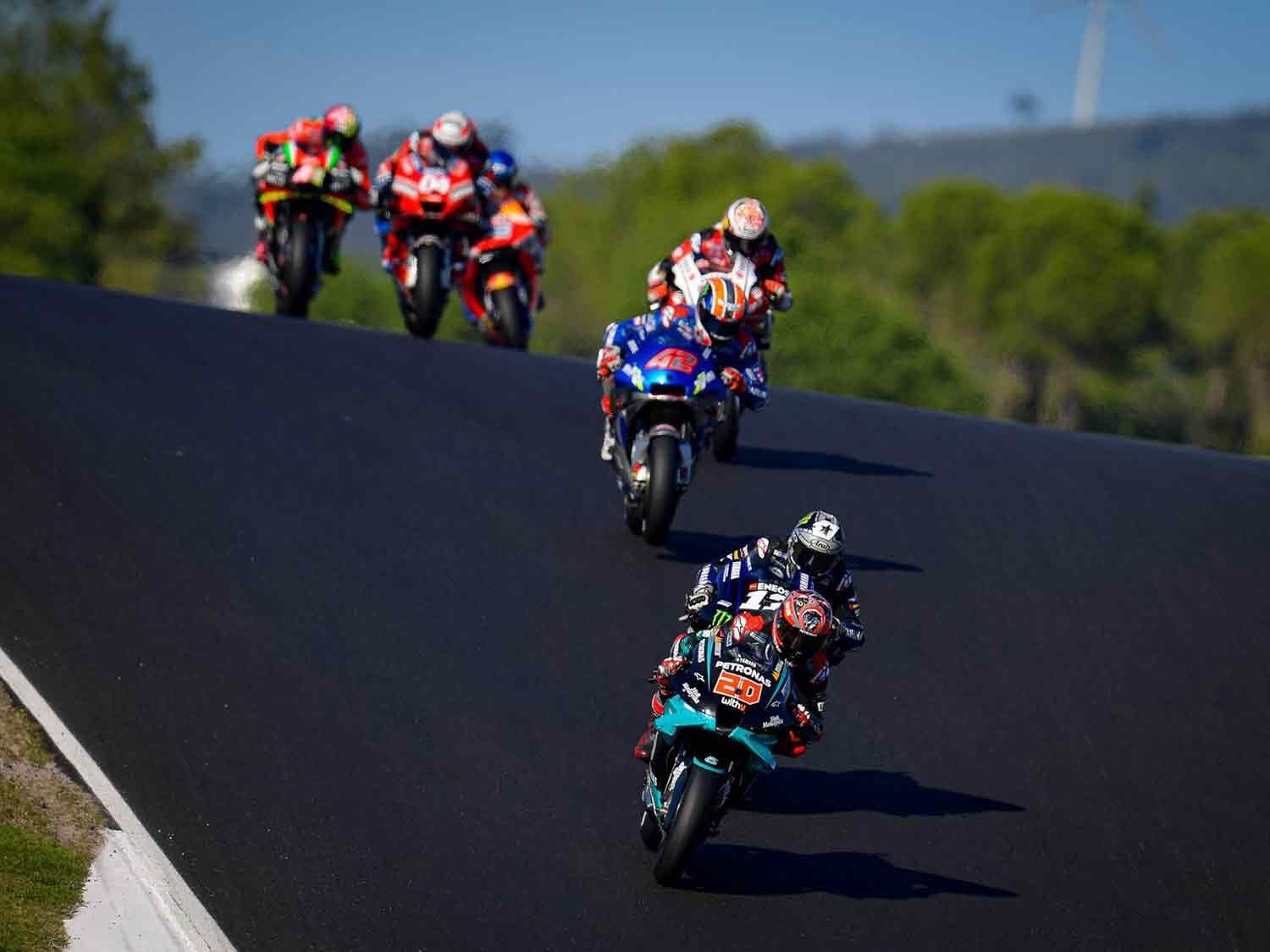
The undulations and bumps of Portimão made setup difficult for the super-stiff MotoGP bikes. (MotoGP/) In the race, Oliveira was master of ceremonies and pulled away. Miller said, “He went away so fast from me and Franky (Morbidelli) that the win was pretty much off the table about two laps in.
After his win he said, “It was long! … I didn’t want to look at the board for the first three laps. I just wanted to do my pace and my lines and try to see if anyone would go for a lunge on the inside.”
But he was alone.
“After FP4 I realized I had something more. I pushed from the start without looking back, but managing the tires and the advantage in the final laps was not easy.”
By lap 21 he led by 4.597 seconds.
The drama was behind him: a resumption of the Morbidelli-Miller battle which Morbidelli had won at Valencia 2. This time the finish was reversed as Miller-Morbidelli.
About his own setup, Miller said, “…it’s a challenge to work out your setup and where you might have to sacrifice on one corner to make the bike better for others. I’ve really found my groove again with the bike in the last few races…”
Morbidelli, too, had found Oliveira unapproachable: “(He)…had something extra today and we weren’t able to follow him.”
Dovizioso, leaving the Ducati team, fought through to sixth place, which is where Ducatis were finishing when he first came on the scene. Cal Crutchlow, also saying his goodbyes, finished 13th after a strong fourth in qualifying. I will miss the education both have given me in their words.
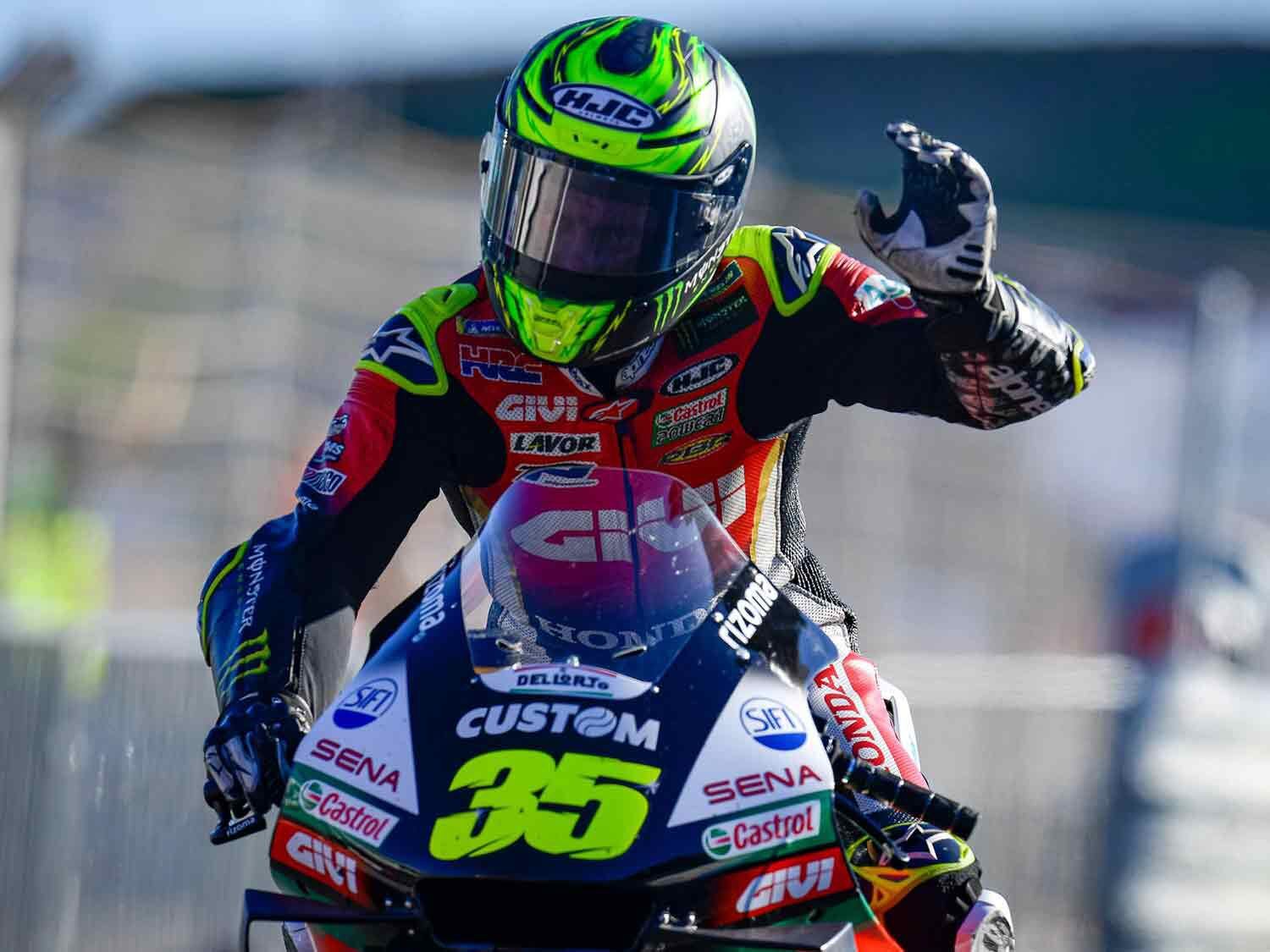
Cal Crutchlow finished his final MotoGP race in 13th. (MotoGP /) This year results have often seemed more like a lottery than a result of discoverable cause and effect. It’s tempting to just accept randomness in thoughts like: “Yamaha is out of it, except for a strong Morbidelli and sometimes Quartararo. Ducati is out of it, except for Miller, who seems to have some grasp of his fate. KTM is at last solidly on its way (three wins this year, two bikes in the top five today), but Honda must for the moment be content with the occasions when Nakagami or Alex Márquez has a good day and stays upright. Will Marc Márquez bring back the past, or will time’s arrow have flown on? Unknowable, so 2021 will see what Pol Espargaró can do as a hedge. Can Yamaha break out of its comfortable years of having nearly enough rear grip in the spring and not nearly enough in the fall? Will Ducati continue its fascination with braking stability and acceleration, to the exclusion of grip at the apex? Will Suzuki, the present master of all-around performance, emerge as a dominant force in 2021?”
As the Japanese manufacturers focus ever-more tightly on their Asian markets and backpedal in the West, the push and shove of sales competition is heating up Europe. That competition is the only good reason to race.
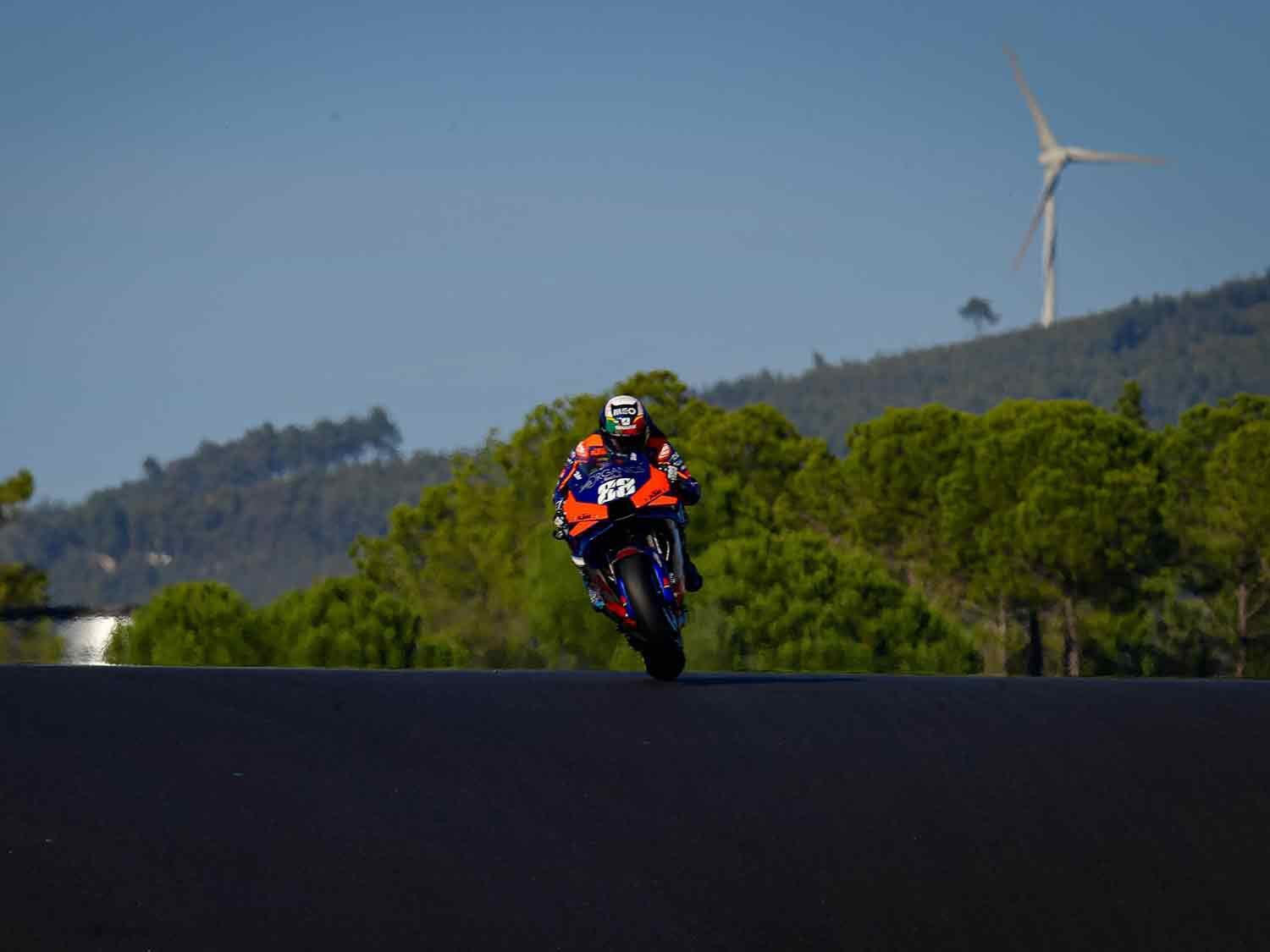
What will be in 2021? Will teams like Tech3 continue to see success when Marc Márquez returns to competition? (MotoGP/) If what MotoGP has to sell is suspense, this year brought a bumper crop, as up-and-coming riders up-and-arrived, gaining in confidence and experience. Will they wilt in 2021 as Marc Márquez returns full strength to shade them out? No one rider stands out, for the system now in place has provided all with the same excellent schooling of national series, then Moto3 and Moto2 to prepare the top performers for MotoGP. Meanwhile a series of schemes to put competitive bikes on the start grid has succeeded in placing each arriving graduate on a fully engineered bike, designed from the start as a factory MotoGP machine. This has brought machine and rider parity comparable to that of Moto2 while preserving the proven appeal of many brands in contention.
Prospects for a return of this suspense in 2021 look good.
-
Hello wolf125,
Welcome to The Motorbike forum. Please feel free to browse around and get to know the others. If you have any questions please don't hesitate to ask.
Why not tell us a bit about yourself too.
-
Hello Andyrew,
Welcome to The Motorbike forum. Please feel free to browse around and get to know the others. If you have any questions please don't hesitate to ask.
-
Hello Basshead,
Welcome to The Motorbike forum. Please feel free to browse around and get to know the others. If you have any questions please don't hesitate to ask.
-
Hello onedreamride,
Welcome to The Motorbike forum. Please feel free to browse around and get to know the others. If you have any questions please don't hesitate to ask.
-
-
Hello Dossie,
Welcome to The Motorbike forum. Please feel free to browse around and get to know the others. If you have any questions please don't hesitate to ask.
-
Hello SteveO,
Welcome to The Motorbike forum. Please feel free to browse around and get to know the others. If you have any questions please don't hesitate to ask.
-
Hello Raijin,
Welcome to The Motorbike forum. Please feel free to browse around and get to know the others. If you have any questions please don't hesitate to ask.
-
Hello Jim,
Welcome to The Motorbike forum. Please feel free to browse around and get to know the others. If you have any questions please don't hesitate to ask.
-
Hello Emily,
Welcome to The Motorbike forum. Please feel free to browse around and get to know the others. If you have any questions please don't hesitate to ask.
-
Hello Dai Loughor,
Welcome to The Motorbike forum. Please feel free to browse around and get to know the others. If you have any questions please don't hesitate to ask.
-
-
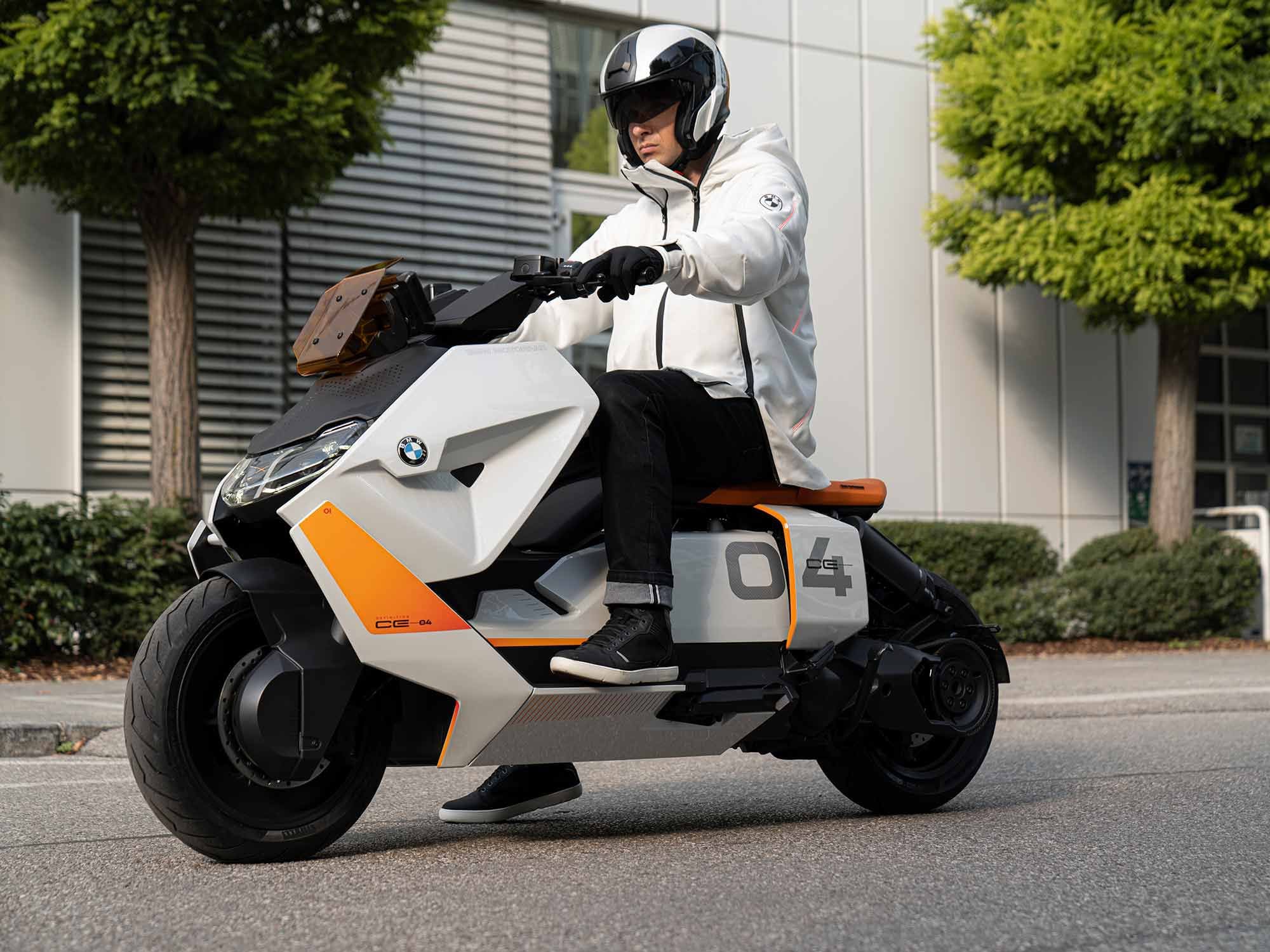
BMW recently showed off the Definition CE 04 electric scooter. Where are the motorcycles? (BMW Motorrad/) BMW has recently treated the press to a non-contact digital look at its far-reaching plans for future automobile electrification, safety, connectedness, and autonomy, but save for the new Definition CE 04 electric scooter, said to be close to production, the presentation passed over two-wheeled plans.
RELATED: BMW Radical New Electric Scooter
This makes sense because: 1) automakers must scramble hard for places on the escalator to the fast-evolving auto future, yet 2) it’s hard to envision BMW’s established motorcycle line of long-distance tourers and adventure bikes being successfully electrified at this point. As a learning experiment, at the end of 2016 the company gave the urban transportation field a whirl by announcing the BMW C Evolution electric scooter. Reviewers gave it decent marks as a test of concept, but at its 15,000 euro price (that’s US $17,850 today), 606-pound weight, and limited on-board storage (batteries take up a lot of volume) it was not for nimbly beating traffic while carrying out impulse shopping raids.
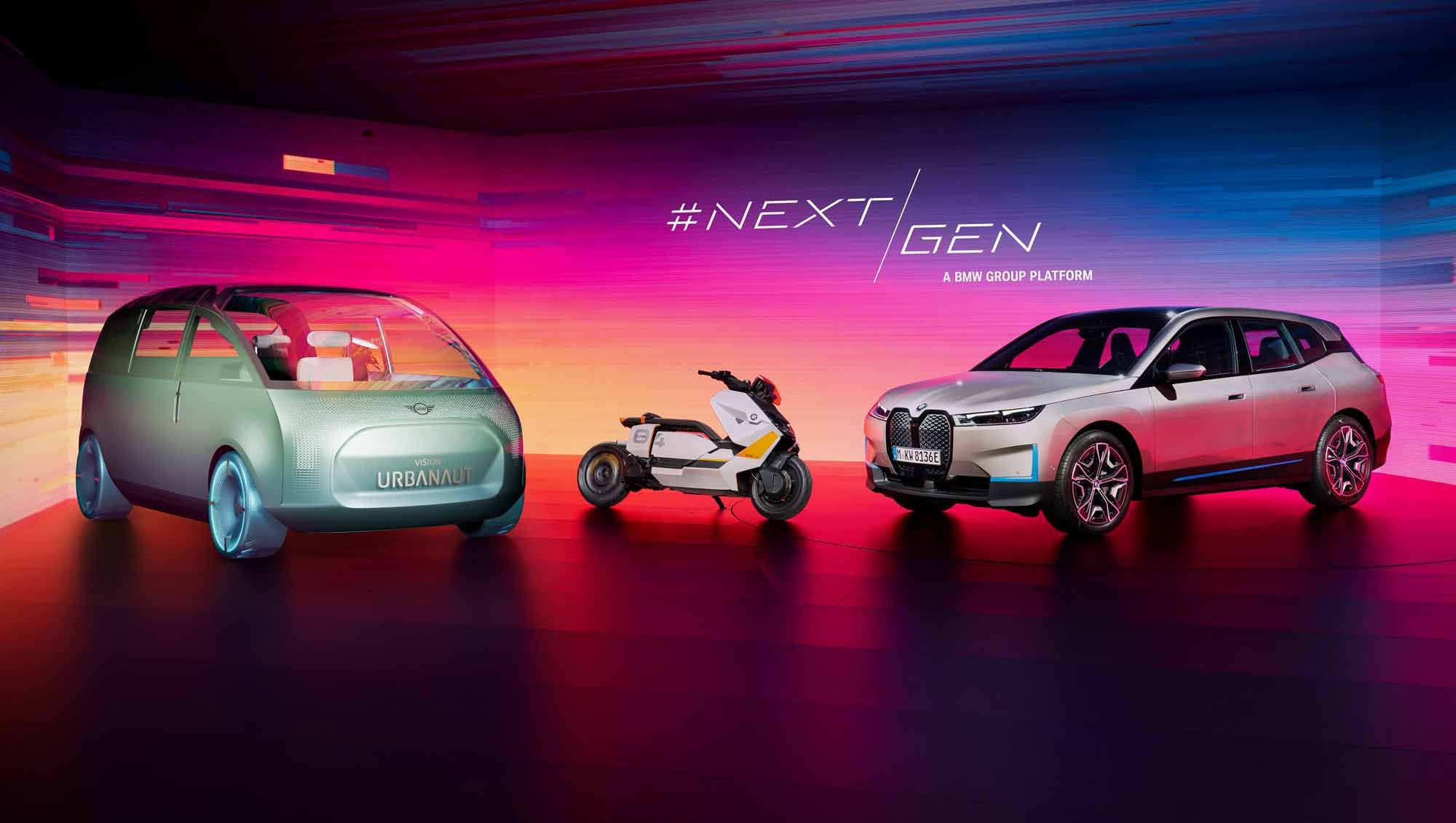
The Definition CE 04 was the only two-wheeled BMW in the #NEXTgen 2020 presentation. (BMW Motorrad/) Based upon experience with C Evolution, the correct properties of an urban transport module became clearer. For a likely daily commute of 12 kilometers (7.5 miles) and on the needs for ease of handling (the classic Vespa, as seen in the 1953 movie Roman Holiday, weighed 253 pounds!) and the secure carriage of parcels, the vehicle was redesigned. The engineers reduced battery weight, putting it where you least feel it (under the floor pan) with performance realistic for the application. Helmet-size underseat storage was added.
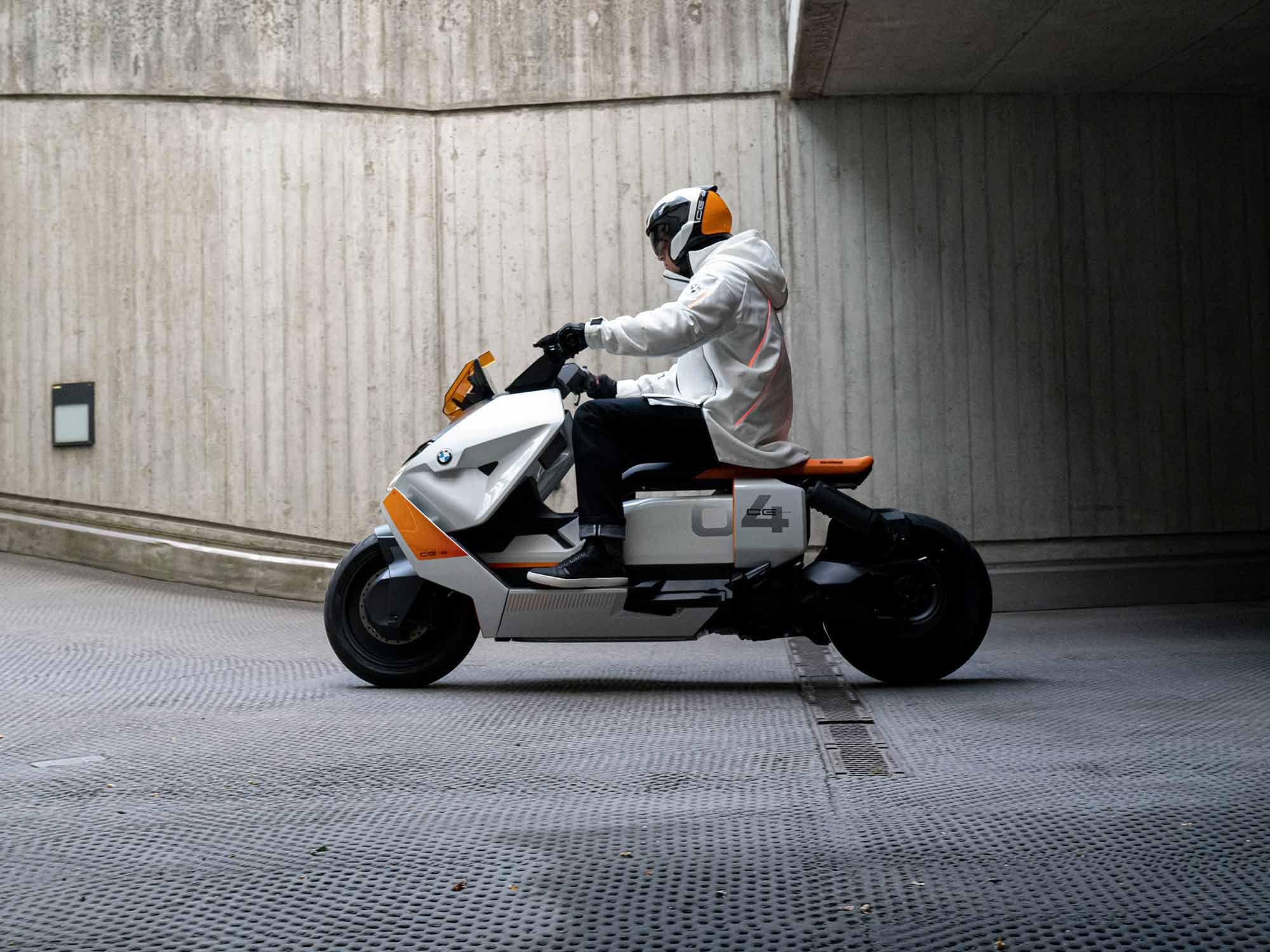
Reduced battery weight placed lower in the chassis than the C Evolution scooter is said to make the Definition CE 04 more suitable for the rigors of urban use. (BMW Motorrad/) No real specifications or likely price were released, but at the rear, a glimpse of mechanism confirms a single-sided swingarm, cog belt drive, and single-shock suspension. A 10-inch data screen interfaces with your phone to keep you connected and updated. Finally, the vehicle delivers the radical style you see here, in line with Europe’s current love affair with origami. Don the matching riding gear, singling you out as part of the solution, not part of the problem. The jacket illuminates to signal braking or turning, while wirelessly charging your phone in its dedicated pocket. Savor an abstract, unknowable, but infinitely cool electric future.
It’s not in showrooms yet but BMW tells us that something close is coming very soon, likely within a year.
-
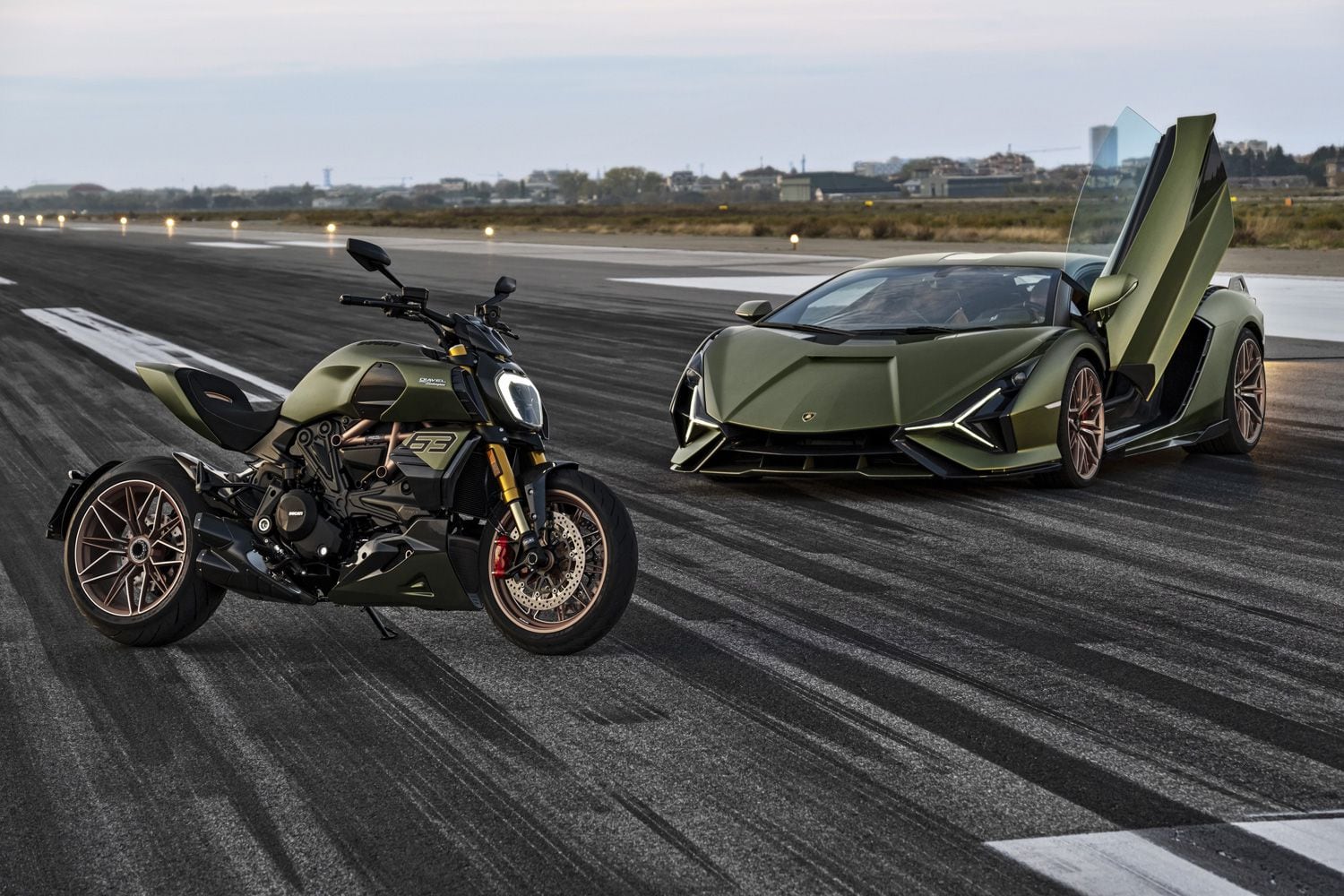
The 2021 Ducati Diavel 1260 Lamborghini is inspired by the Lamborghini Sián FKP 37 supercar. (Ducati/) If you think hard, Ducati’s power cruiser, the Diavel, remains a big question mark 10 years on from its introduction. Then-CEO Gabriele Del Torchio was negotiating the acquisition of Ducati by Audi and he really wanted to polish all the silverware in order to trade the Borgo Panigale motorcycle brand at the highest possible price. Ducati was VW-Audi boss Ferdinand Piëch’s special gift for his 75th birthday. He wanted Ducati badly because he had been a long believer of Dr. Taglioni’s desmodromic valve actuation. Del Torchio wanted to add new models into Ducati’s Pandora box, and so he forced his technical team to give life to something absolutely outstanding that would add more value to the marque.
Enter the Panigale 1200 and the Diavel. The Panigale 1200, powered by the most advanced and fascinating V-twin in history, built in the Ducati tradition of supreme superbikes. Diavel was almost the opposite, a model that was treading on unknown turf. In the Ducati way, the Diavel was loaded with power never seen before on a cruiser and was styled to the extreme. Sure, it proved the most powerful, the fastest cruiser in production, and it did it in good composure thanks to a sportbike-derived chassis. But how the Diavel was perceived by cruisers communities around the world and how well it fared on the market we will never know for sure. “Mixed” is the best way to interpret the market’s reaction.
To me it seems that it has lived on a sequence of well-publicized numbered “special editions” that helped keep the name alive. The recent XDiavel Dark and Black Star are part of this marketing policy, and now comes the ultimate variation: the Ducati Diavel 1260 Lamborghini.
Ducati and Lamborghini both are under the umbrella of the Audi Group and their factories are set few miles apart in that very special section of Italy known as Motor Valley where in less than 70 miles you go from Dallara in Parma, to Ferrari and Maserati in Modena, to Ducati in Bologna, plus a myriad of fantastic little shops where grinders and lathes and CNC machinery turn out mechanical components that are real jewels.
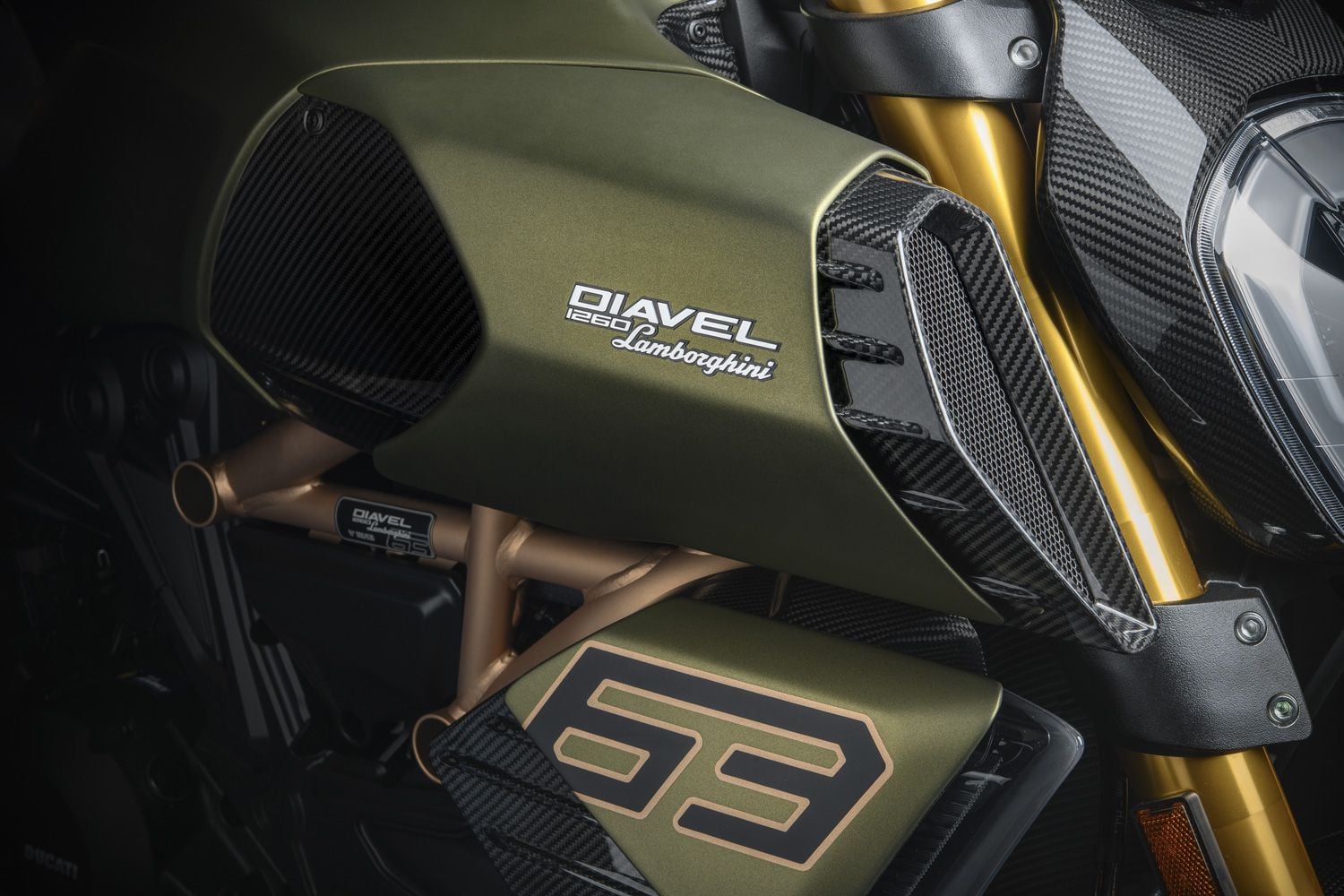
Both Ducati and Lamborghini are part of the Audi Group; now the two have worked together to create a special-edition Diavel 1260. No pricing is set as of yet, but expect it to be expensive and sell out quickly. (Ducati/) Ducati and Lamborghini joined styling department forces to create a very special edition of the Diavel, vastly inspired by the unique Lamborghini Sián FKP 37, the most powerful Lamborghini ever designed that will be manufactured in a numbered batch of 63 units, to celebrate the year Lamborghini was founded—1963. Its unique, hybrid power unit delivers a total of 819 hp.
First, the Diavel 1260 Lamborghini shares the same very special tone of metallic green known as Gea Green. New panels and air intakes have been added to complete the design of the Diavel and make it more muscular and car inspired. Every detail shows supreme quality execution. The relationship with the Sián FKP 37 is strongly underlined by the forged aluminum wheels featuring the same spoke design and the same gold coloring, shared also by the classic steel tubing trellis frame. With the help of extensive use of carbon fiber body parts, plus exhaust system tips, the Diavel 1260 Lamborghini keeps its dry weight at a claimed 485 pounds. Only a touch of red comes from the Brembo front brake Monoblock calipers.
As its identification announces, the Diavel 1260 Lamborghini is powered by the very special 1,262cc variation of the Testastretta Ducati 90-degree V-twin featuring the unique DVT (aka Desmo Variable Timing) to deliver a solid 162 hp at 9,500 rpm and a generous 95 pound-feet of peak torque at 7,500 rpm in this new Euro 5 homologated execution.
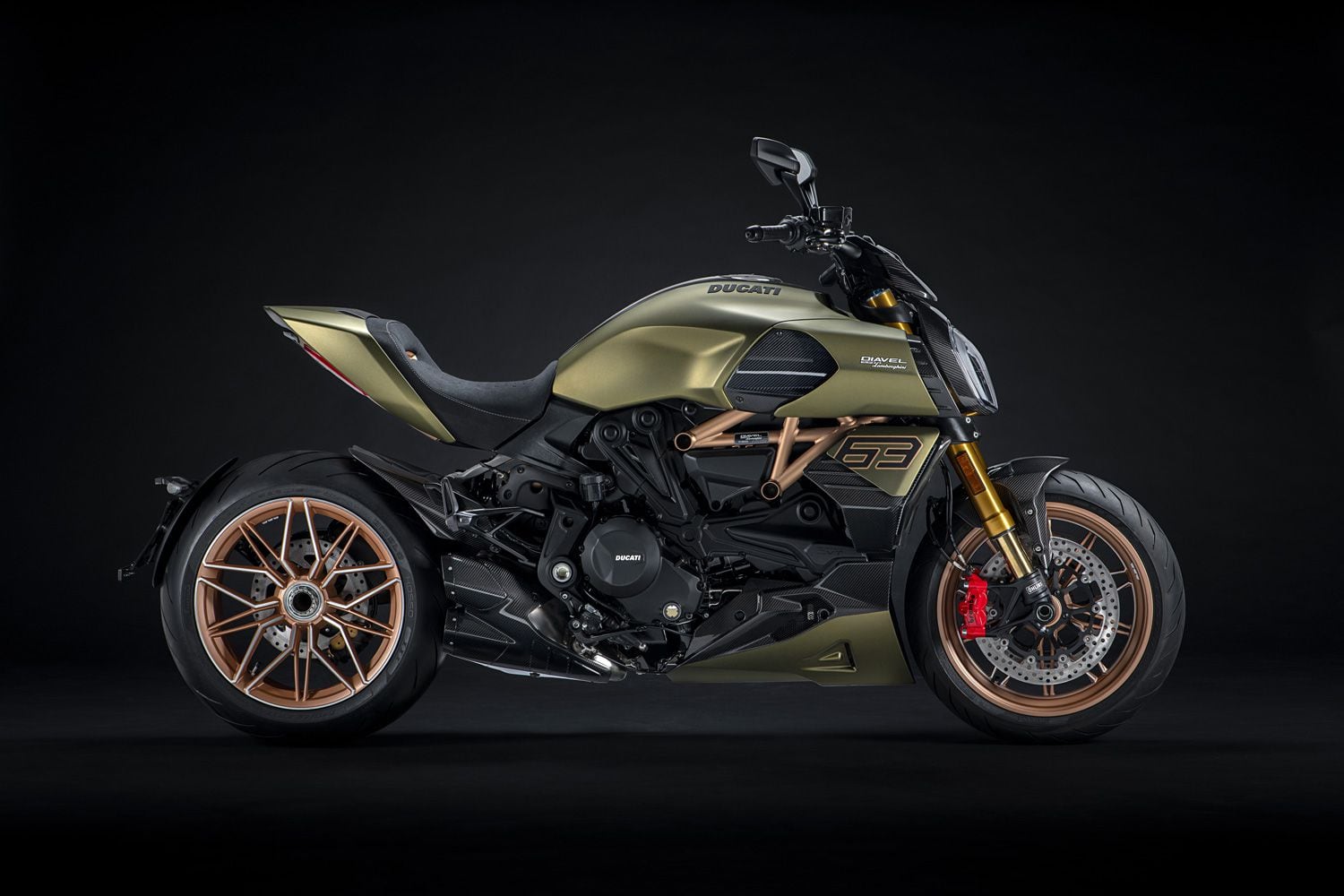
The 2021 Ducati Diavel 1260 Lamborghini is available in only one color: Gea Green with Electrum Gold frame and wheels. (Ducati/) Suspension is by Öhlins: A 48 millimeter fork and gas-charged rear monoshock, both fully adjustable. The electronics suite is top class, based on a Bosch six-axis inertial platform 6D IMU that manages all major riding and safety assist functions: ABS cornering control, traction and wheelie control, and power launch control. The TFT display of the instrumentation manages the Ducati Multimedia connectivity system.
To underline the association with the Lamborghini supercar, Diavel 1260 Lamborghini shows a big number “63” on the radiator side panels, but in this case the numbered units will be 630. Price to be announced at a later date.
-
Hello jackzi,
Welcome to The Motorbike forum. Please feel free to browse around and get to know the others. If you have any questions please don't hesitate to ask.
-
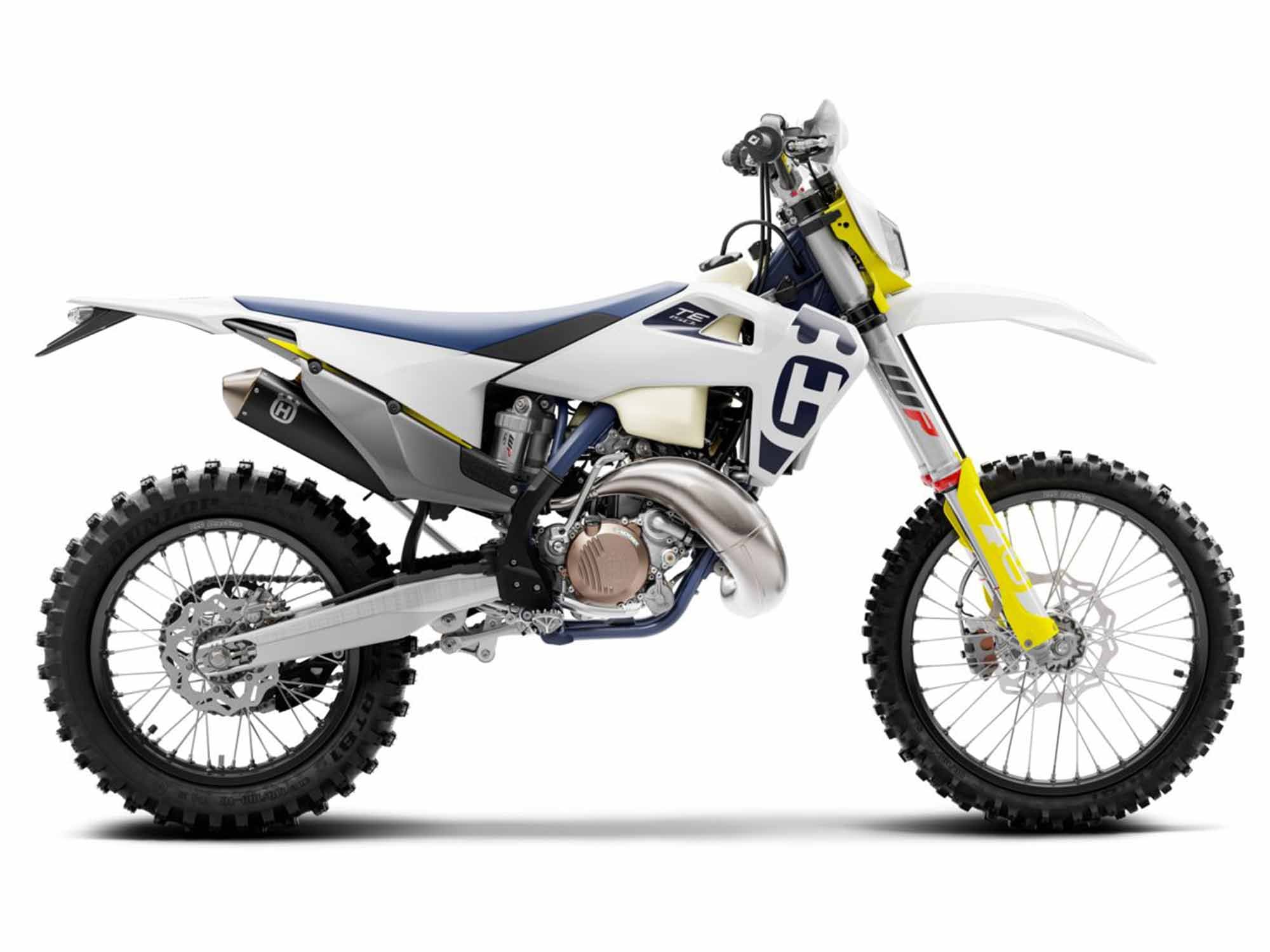
2020 Husqvarna TE 150i (Husqvarna/) The Husqvarna TE 150i is a two-stroke dirt bike designed for the trails and at 219 pounds (dry, claimed weight) is the lightest model in the range, Husky says. Its light weight and nimbleness are useful for slaloming in between trees while the WP Xplor and WP Xact front and rear suspension deliver consistent damping over terrain thanks to refining updates made for the 2020 MY. Other features include Magura brakes, toggleable mapping options, an electric starter, and, the biggest change for 2020, electronic fuel injection. This is one trick enduro bike.
2020 Husqvarna TE 150i Reviews, Comparisons, And Competition
When Dirt Rider took the 2019 TE 150 out on the trails in New York, the test rider reported that the TE cut through trails and obstacles with ease and that its “impressive power-to-weight ratio allow a rider to be aggressive with an easily managed powerband.”
Competition for this fuel-injected two-stroke includes the TM EN 144 Fi and KTM 150 XC-W TPI. For those not as concerned with displacement as they are with having a unique brand of off-road bike, you can look toward the Sherco 125 SE Racing model or Beta 125 RR as the TE’s other competition.
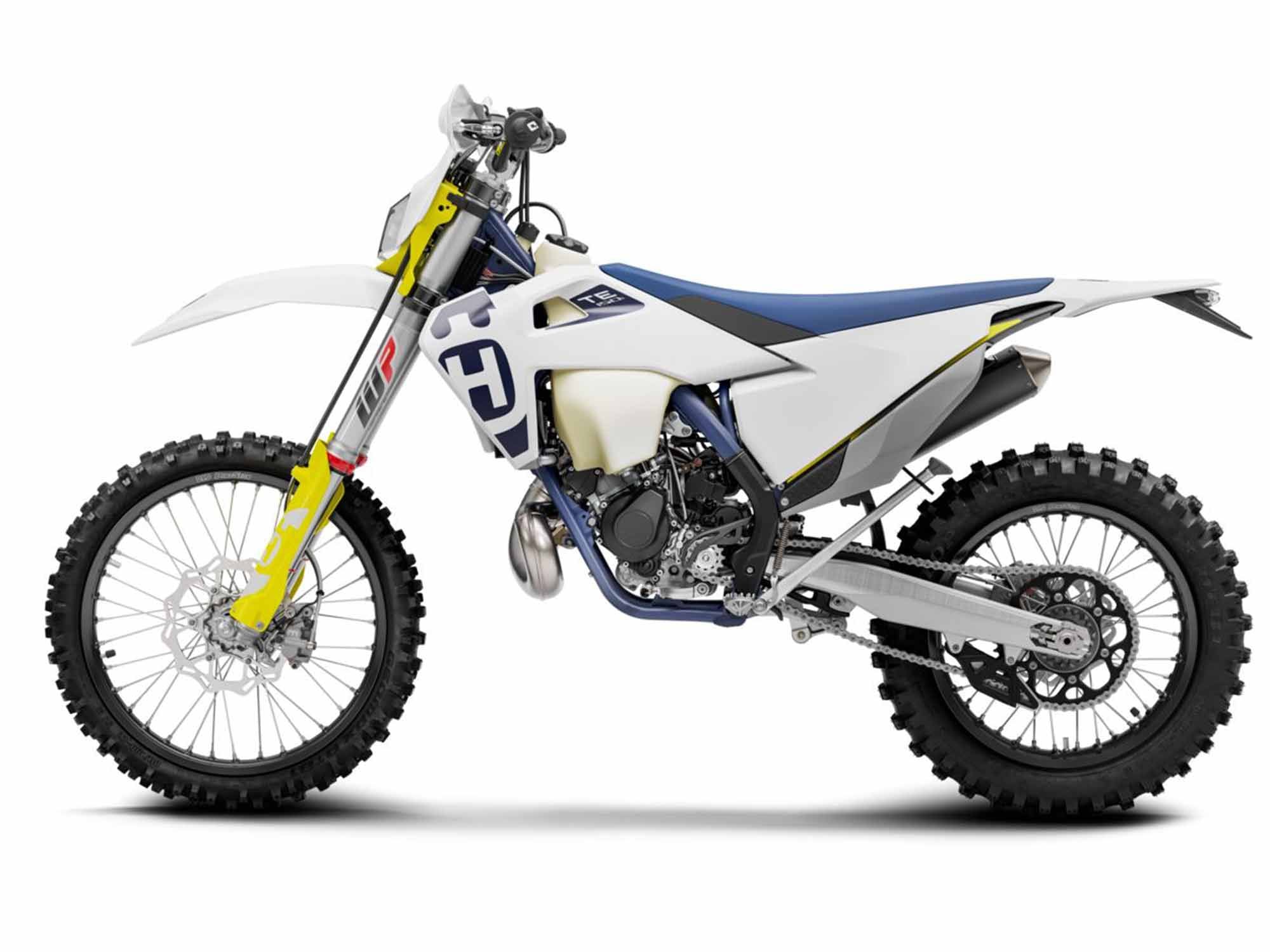
2020 Husqvarna TE 150i (Husqvarna/) Husqvarna TE 150i Updates For 2020
The 2020 TE 150i (and the whole Husqvarna Enduro line) have undergone major updates to the chassis, suspension, and bodywork. More specifically, this includes a more rigid frame (Husky specifies for more longitudinal and torsional rigidity), a claimed 250-gram-lighter carbon fiber subframe, new aluminum cylinder head mountings, and updated suspension that offers “simple adjustment, more consistent damping, and better resistance to bottoming,” Husky says. The TE 150i also now shares the same two-stroke electronic fuel-injection tech as the TE 250i and TE 300i. Across the MY20 range, the models also see a claimed 0.4-inch drop in seat height. New bodywork and graphics are just the cherry on top.
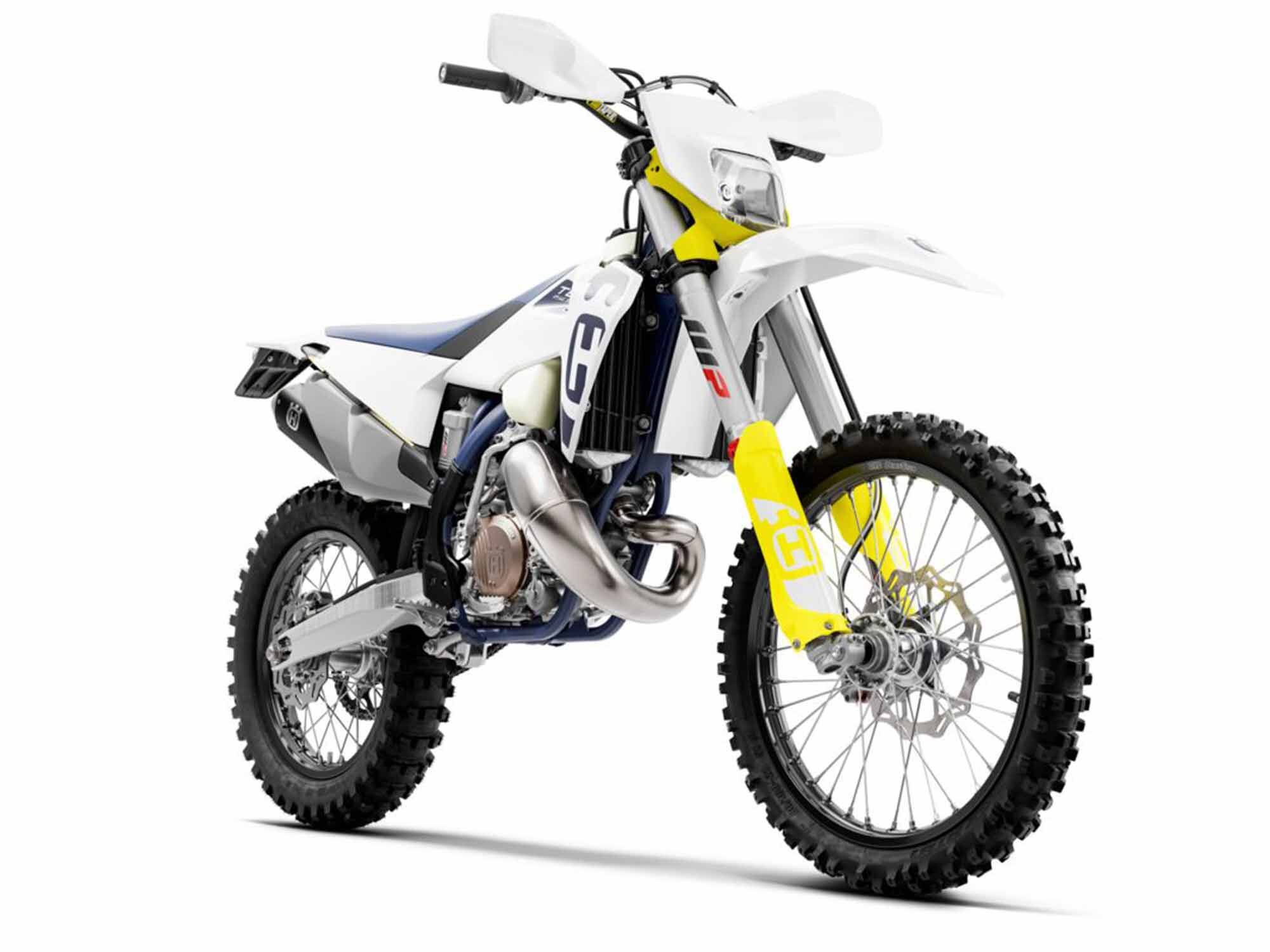
2020 Husqvarna TE 150i (Husqvarna/) 2020 Husqvarna TE 150i Claimed Specifications
Price: $8,899 Engine: Liquid-cooled single-cylinder two-stroke Liquid-cooled SOHC single-cylinder Displacement: 144cc Bore x Stroke: 58.0 x 54.5mm Horsepower: N/A Torque: N/A Transmission: 6-speed Final Drive: Chain Seat Height: 37.4 in. Rake: 26.5° Trail: N/A N/A Front Suspension: 48mm inverted fork, fully adjustable; 11.8-in. travel Rear Suspension: Fully adjustable; 11.8-in. travel Front Tire: 90/90R-21 Rear Tire: 140/80R-18 Wheelbase: 58.5 in. Fuel Capacity: 2.3 gal. Dry Weight: 219 lb. -
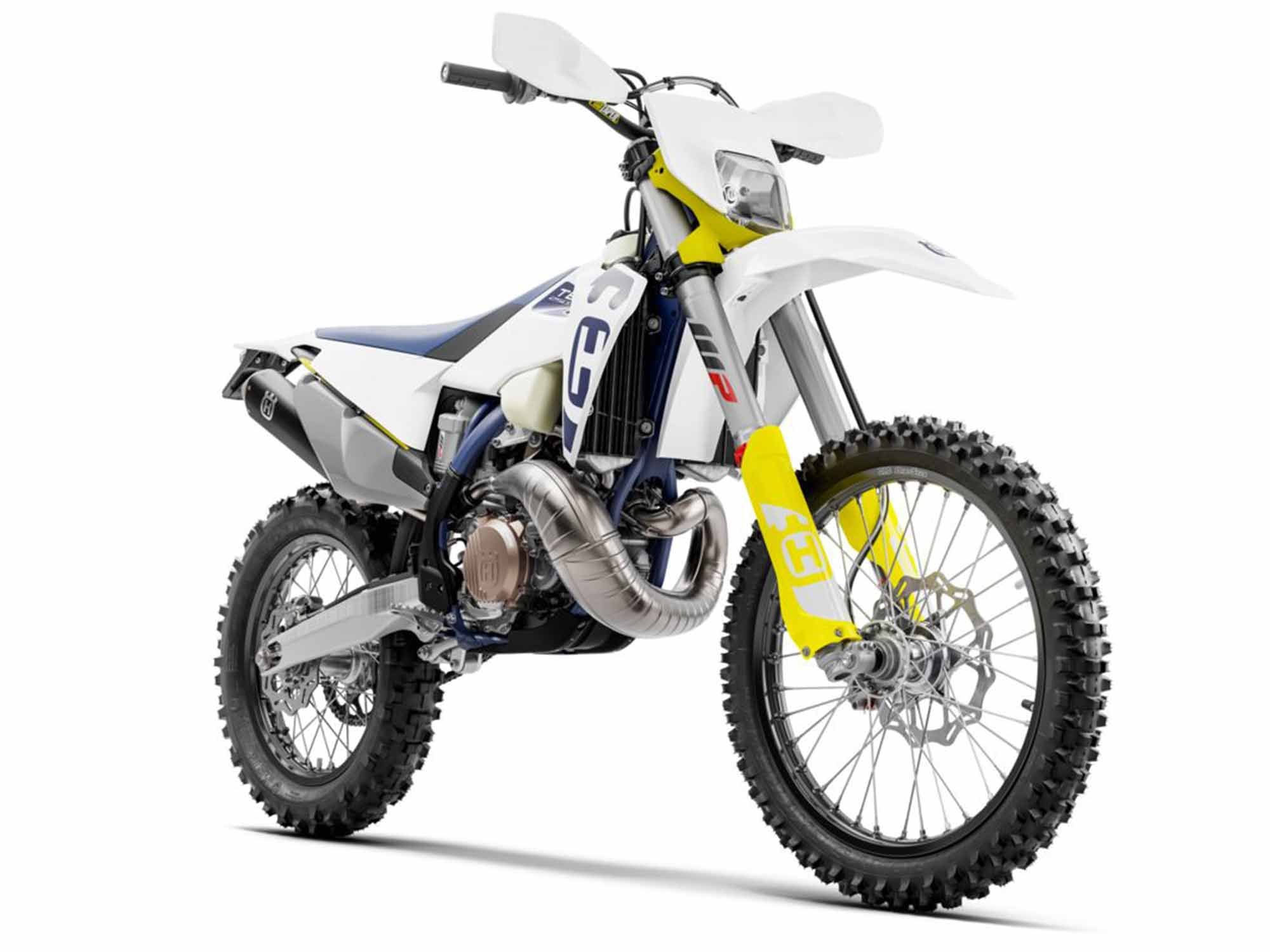
2020 Husqvarna TE 250i (Husqvarna/) The Husqvarna TE 250i is the brand’s two-stroke enduro model that features electronic fuel injection (indicated by the “i” in the model name). Although two-strokes have been increasingly replaced by four-stroke models, Husqvarna still sees value in enhancing the two-strokes with the new-age tech—no more premixing fuel or making jetting changes. Getting into the internals of the machine, Husqvarna says, “With a heavier ignition rotor, the crankshaft produces more inertia than its motocross counterpart [TC 250], which improves control in the lower rpm,” a valuable feature for when traversing the single-track where slow riding technique is key.
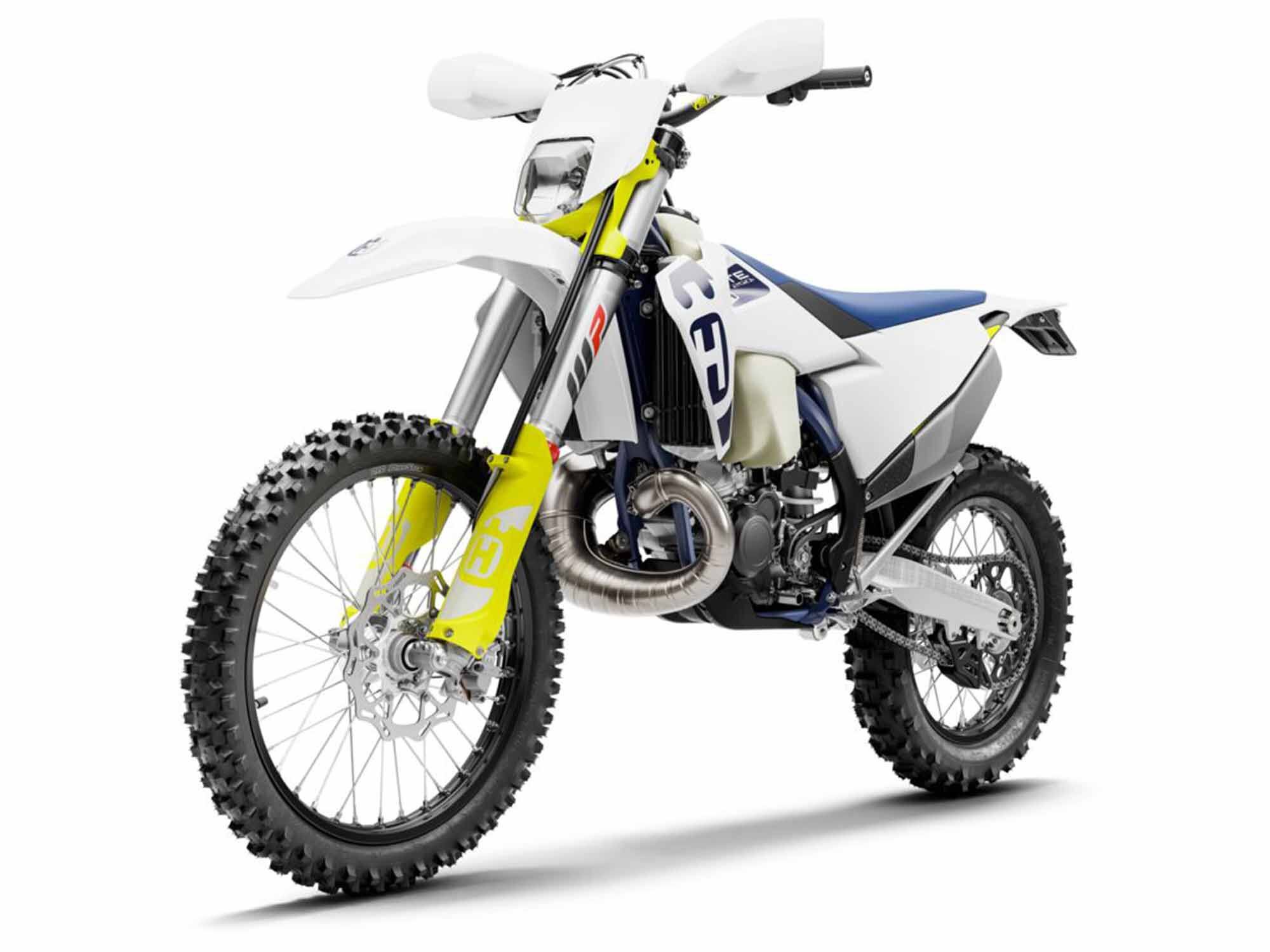
2020 Husqvarna TE 250i (Husqvarna/) 2020 Husqvarna TE 250i Reviews, Comparisons, And Competition
When the fuel-injected model was introduced in 2018, test rider Andrew Oldar found the 250 was “noticeably more flickable” than its 300 counterpart, which is good news considering the 250 was the one to make it stateside that year. Oldar wrote that the 250i engine performed well at super-low rpm in first gear but even better in second gear on more technical single-track trails.
Spinning the rear wheel on our in-house dyno, the 2019 Husqvarna TE 250i’s fuel-injected engine produced 40.74 hp at 8,230 rpm and 27.49 pound-feet of torque at 7,580 rpm.
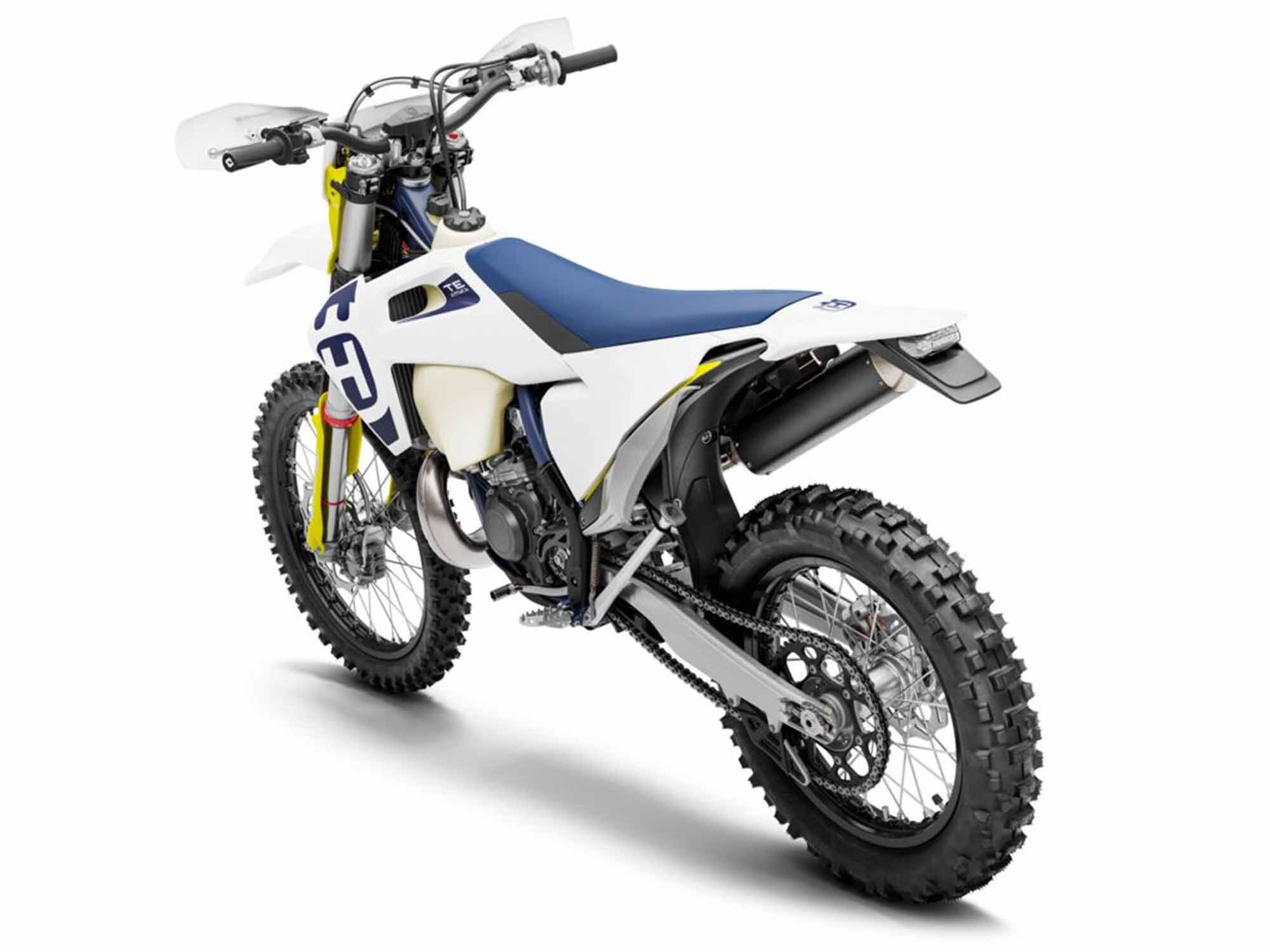
2020 Husqvarna TE 250i (Husqvarna/) Husqvarna TE 250i Updates For 2020
For 2020, Husqvarna updated the cylinder for better performance, added a new water pump casing to improve cooling by optimizing the flow of coolant, lightened the subframe by 0.6 pound, updated suspension, swapped out a new exhaust, and wrapped new bodywork around a new frame.
2020 Husqvarna TE 250i Claimed Specifications
Price: $9,899 Engine: Liquid-cooled single-cylinder two-stroke Displacement: 249cc Bore x Stroke: 66.4 x 72.0mm Horsepower: N/A Torque: N/A Transmission: 6-speed Final Drive: Chain Seat Height: 37.4 in. Rake: 26.5° Trail: N/A Front Suspension: 48mm inverted fork, fully adjustable; 11.8-in. travel Rear Suspension: Fully adjustable; 11.8-in. travel Front Tire: 90/90-21 Rear Tire: 140/80-18 Wheelbase: 58.5 in. Fuel Capacity: 2.2 gal. Wet Weight: 232 lb. -
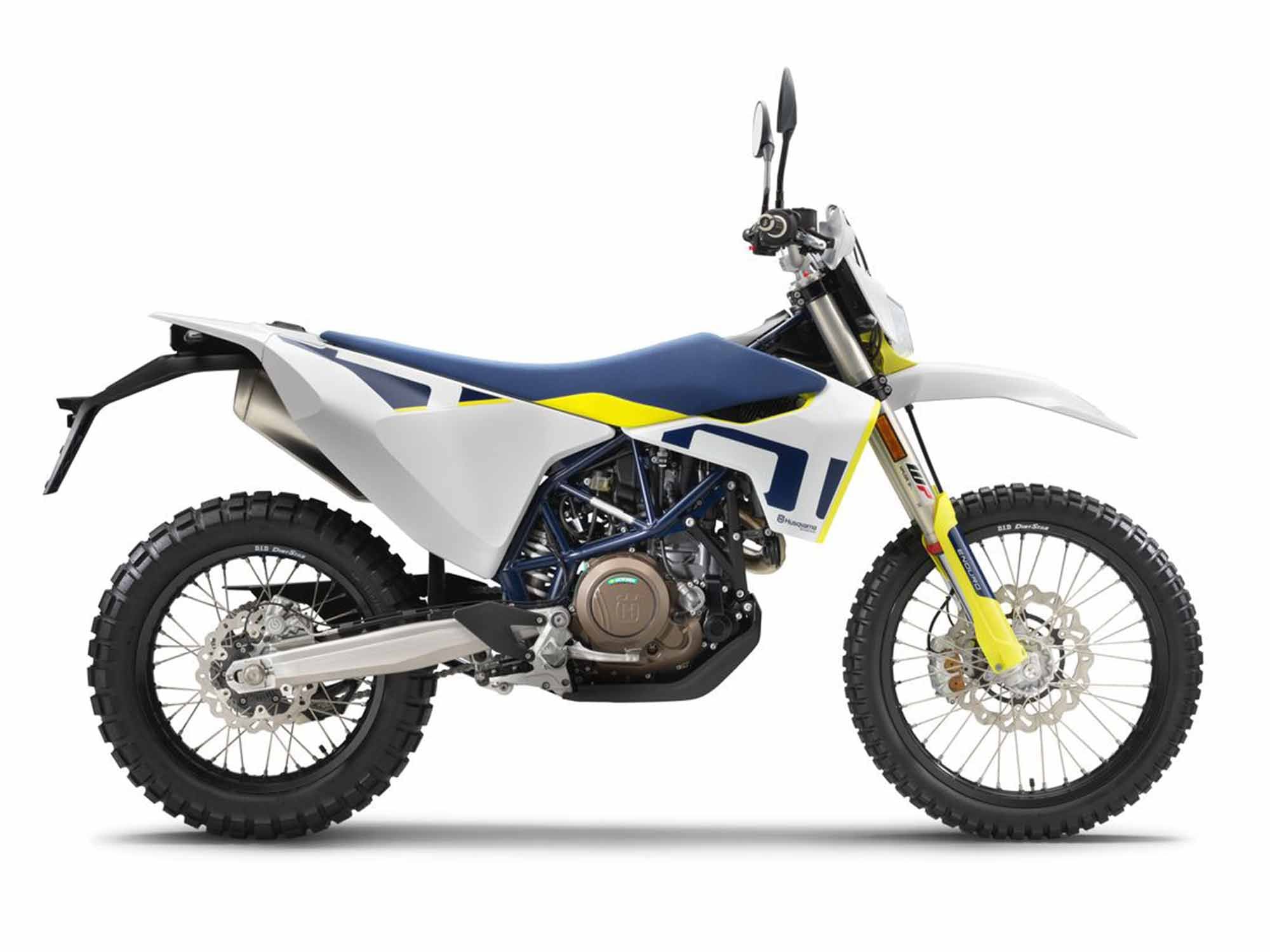
2020 Husqvarna 701 Enduro (Husqvarna/) Husqvarna’s on-road 701 Supermoto meets its dual sport match in the 701 Enduro. These models share more than the $11,999 MSRP, 693cc single-cylinder engine, slim chrome-moly steel trellis frame and fuel-tank-integrated rear subframe. What sets the 701 Enduro apart is how it meets the challenges of the road and dirt with equal capability thanks to WP Xplor suspension and 21- and 18-inch wheels. It also shares electronic rider aids like switchable ride modes, cornering ABS, traction control, and up and down quickshifter with the 701 Supermoto.
2020 Husqvarna 701 Enduro Reviews, Comparisons, And Competition
In our 2016 ride review our test rider said: “Splashing down wide, rain-soaked trails, the Enduro behaved quite well for a 320-pound dirt bike—this despite the shallow depth of the knobs, which preferred to spin rather than grip in such conditions. Keeping the ABS switched to the front-only setting, I was able to slide the rear to get the bike pivoted and pointed out of turns—a useful feature when riding aggressively off-road.”
Competition includes the KTM 690 Enduro R, Honda XR650L, and Suzuki DR650S.
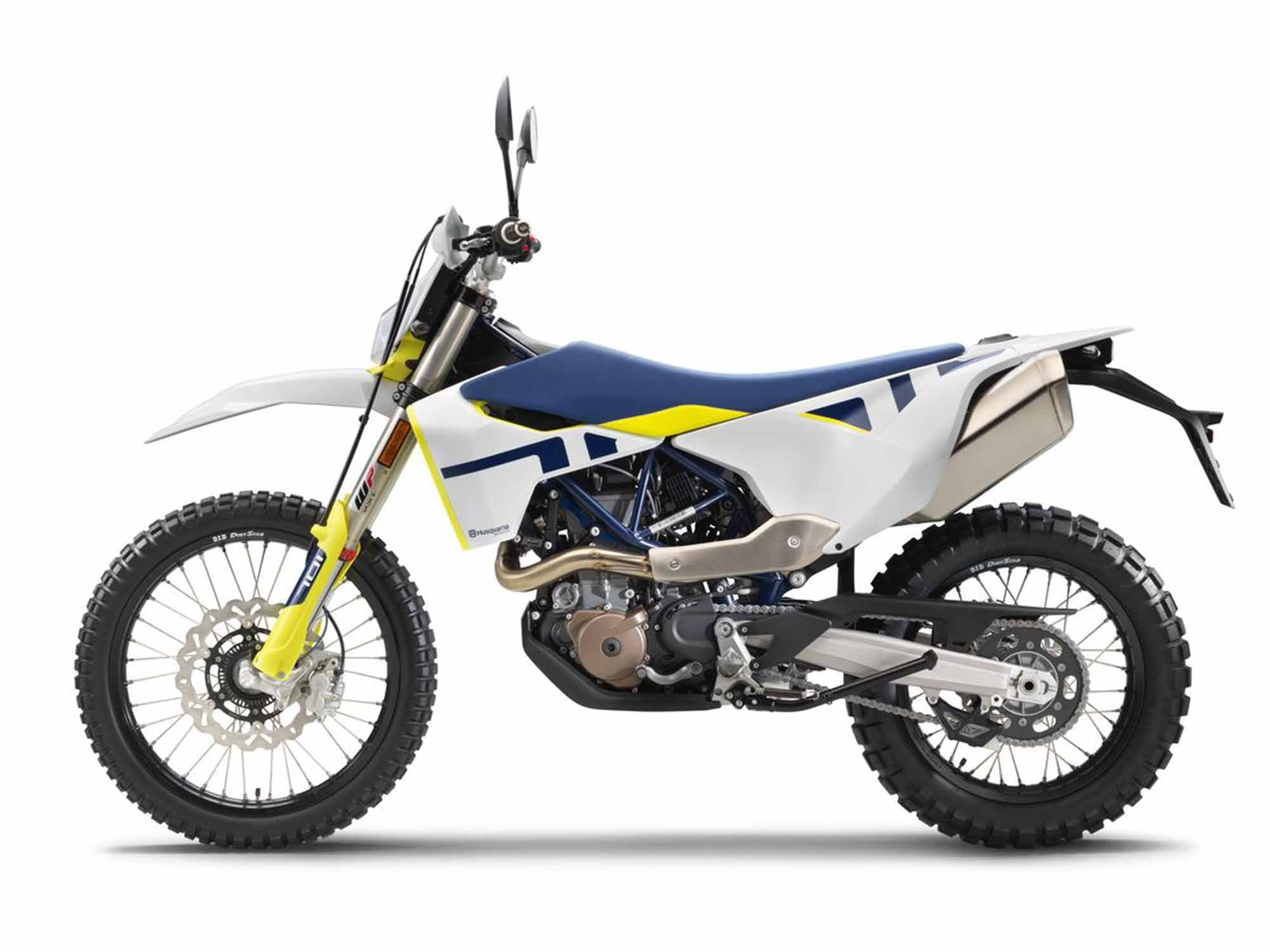
2020 Husqvarna 701 Enduro (Husqvarna/) Husqvarna 701 Enduro Updates For 2020
In addition to the electronic suite and new graphics for the 2020 Enduro, there is also a new addition to the 701 lineup: the 701 Enduro LR (long range). Husky says this shares the same electronics as the 701 Enduro, but offers even more touring capabilities with the addition of the larger 12-liter (3.2 gallons) auxiliary fuel tank to up total fuel capacity to 25 liters (6.6 gallons).
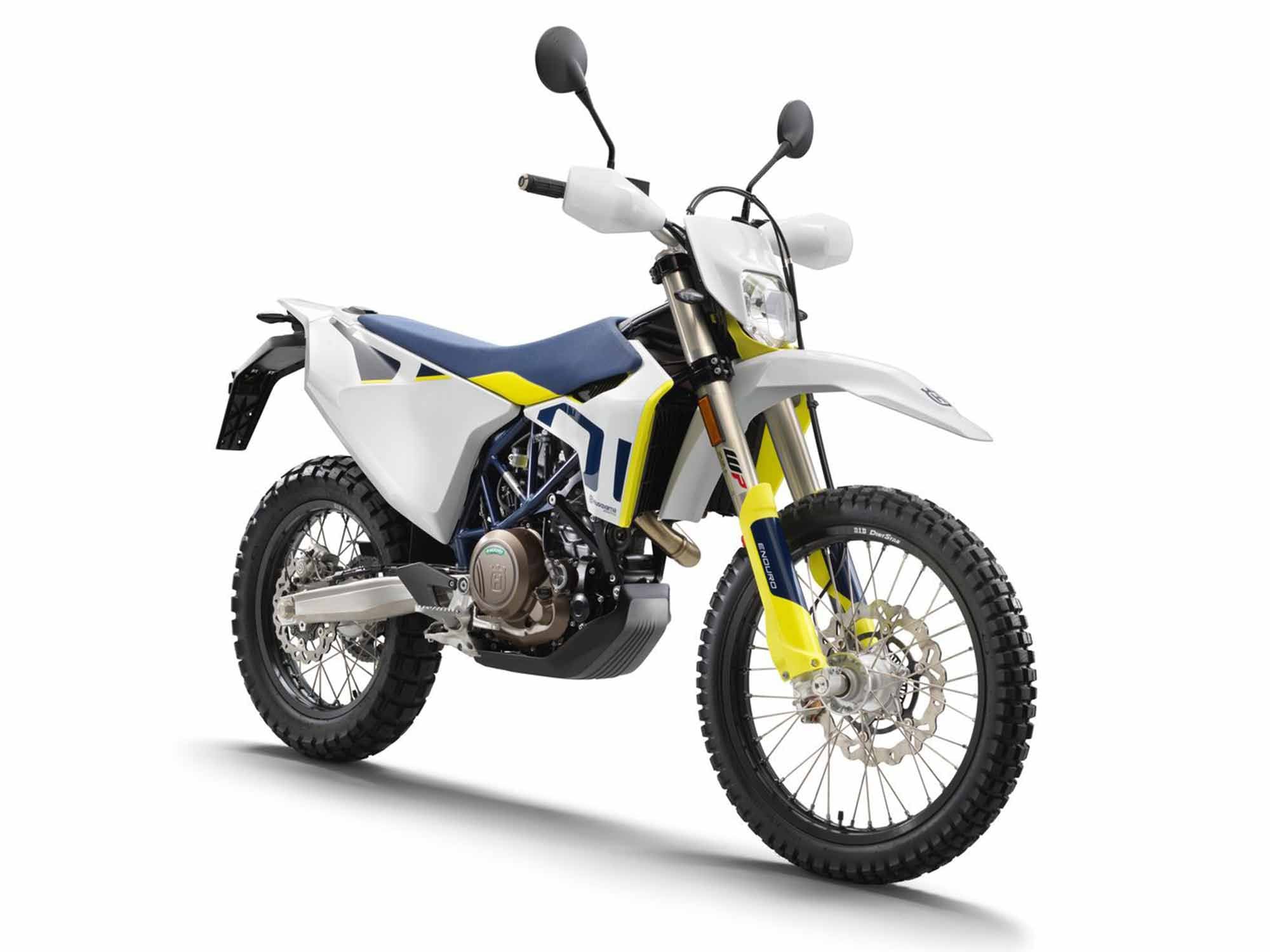
2020 Husqvarna 701 Enduro (Husqvarna/) 2020 Husqvarna 701 Enduro Claimed Specifications
Price: $11,999 Engine: Liquid-cooled SOHC single-cylinder Displacement: 693cc Bore x Stroke: 105.0 x 80.0mm Horsepower: 74.0 hp @ 8,000 rpm Torque: 54.2 lb.-ft. @ 6,500 rpm Transmission: 6-speed Final Drive: Chain Seat Height: 36.2 in. Rake: N/A Trail: N/A Front Suspension: 48mm inverted fork, compression and rebound adjustable; 9.8-in. travel Rear Suspension: Fully adjustable; 9.8-in. travel Front Tire: 90/90R-21 Rear Tire: 140/80-18 Wheelbase: 59.1 in. Fuel Capacity: 3.4 gal. Dry Weight: 322 lb. -
Hello oneaidensl,
Welcome to The Motorbike forum. Please feel free to browse around and get to know the others. If you have any questions please don't hesitate to ask.
-
 1
1
-
-

The 2021 Honda Rebel 1100. (Honda /) For decades, the Honda Rebel has been a stalwart in the small-displacement cruiser category. So it comes as a bit of a surprise that for 2021, Honda is introducing the decidedly un-little Rebel 1100.
If you said someone took the engine out of the CRF1100L Africa Twin, Honda’s flagship adventure bike, and built a cruiser around it, I would have assumed it was some bonkers custom outfit, like El Solitario, those Spanish madmen known for performing sacrilegious acts of customization on perfectly good motorcycles. Well, Honda did the deed itself, putting the parallel-twin engine in a slammed trellis frame. The whole thing actually makes good sense.

The Honda Rebel should be available beginning in January. (Honda /) The 1,084cc parallel twin is retuned for its new application, and features different camshaft profiles for each cylinder. The result is that one cylinder produces slightly more power below 4,000 rpm, while the other produces more above 4,000 rpm. Honda says that in conjunction with the 270-degree crank, the engine provides unique power pulses, which will likely increase the visceral feel of the Africa Twin’s already characterful motor.
The Rebel 1100 is available with a manual six-speed transmission for $9,299, or with Honda’s automatic Dual Clutch Transmission (DCT) for $9,999. With DCT, riders can ride in fully automatic mode or shift using bar-mounted buttons.
It’s equipped with ride-by-wire throttle, and features four power delivery modes (Standard, Rain, Sport, and User-Programmable) and four levels of traction control (Honda Selectable Torque Control). It also features three levels of wheelie control, which isn’t something you find (need?) on every raked-out cruiser.

The Rebel 1100 will be available in Metallic Black and Bordeaux Red Metallic colorways. Honda also has a wide range of accessories to customize the Rebel. (Honda /) Up front, the Rebel has a single massive 330mm disc and radially mounted caliper and a 256mm disc in the rear. ABS is standard. The 130/70-18 (front) and 185/65-16 (rear) tires complete the cruiser look. The Rebel 1100 also has a low 27.5-inch seat-height and claimed curb weight of 487 pounds for the manual model and 509 pounds for the DCT version. Other nice features include cruise control, a lithium-ion battery, and a slip-assist clutch.
With the Rebel 1100, we can see that the latest Rebel 300 and Rebel 500 were a thesis of sorts, exhibiting Honda’s broader vision for the modern cruiser. While Honda’s Shadow and Fury still follow the American cruiser archetype to a large degree, the Rebel lineup has become far less shackled to conventional conceptions of the breed.

LED headlight. The Rebel 1100 has a seamless tank and steel fenders for a premium look. (Honda /) The cruiser market (and cruiser riders) are far more varied than in decades past. It wasn’t too long ago that every cruiser, so went conventional thinking, had to resemble a Harley-Davidson—even if it was a very un-Harley-like small-displacement parallel twin from Japan. The modern cruiser doesn’t have to be air-cooled, a V-twin, or American to be a genuine cruiser (see: BMW R 18). In fact, it’s possible that today’s most successful cruisers are the ones that represent core brand identity more than they represent some outdated notion of the cruiser rider’s identity.

The LCD dash displays the speedometer, tachometer, gear-position indicator, fuel indicator, and ride modes. (Honda/) The Rebel 1100, with its Africa Twin-sourced engine, may be the most Honda-y Rebel ever. Which may be a very appealing prospect for today’s breed of cruiser rider.
-
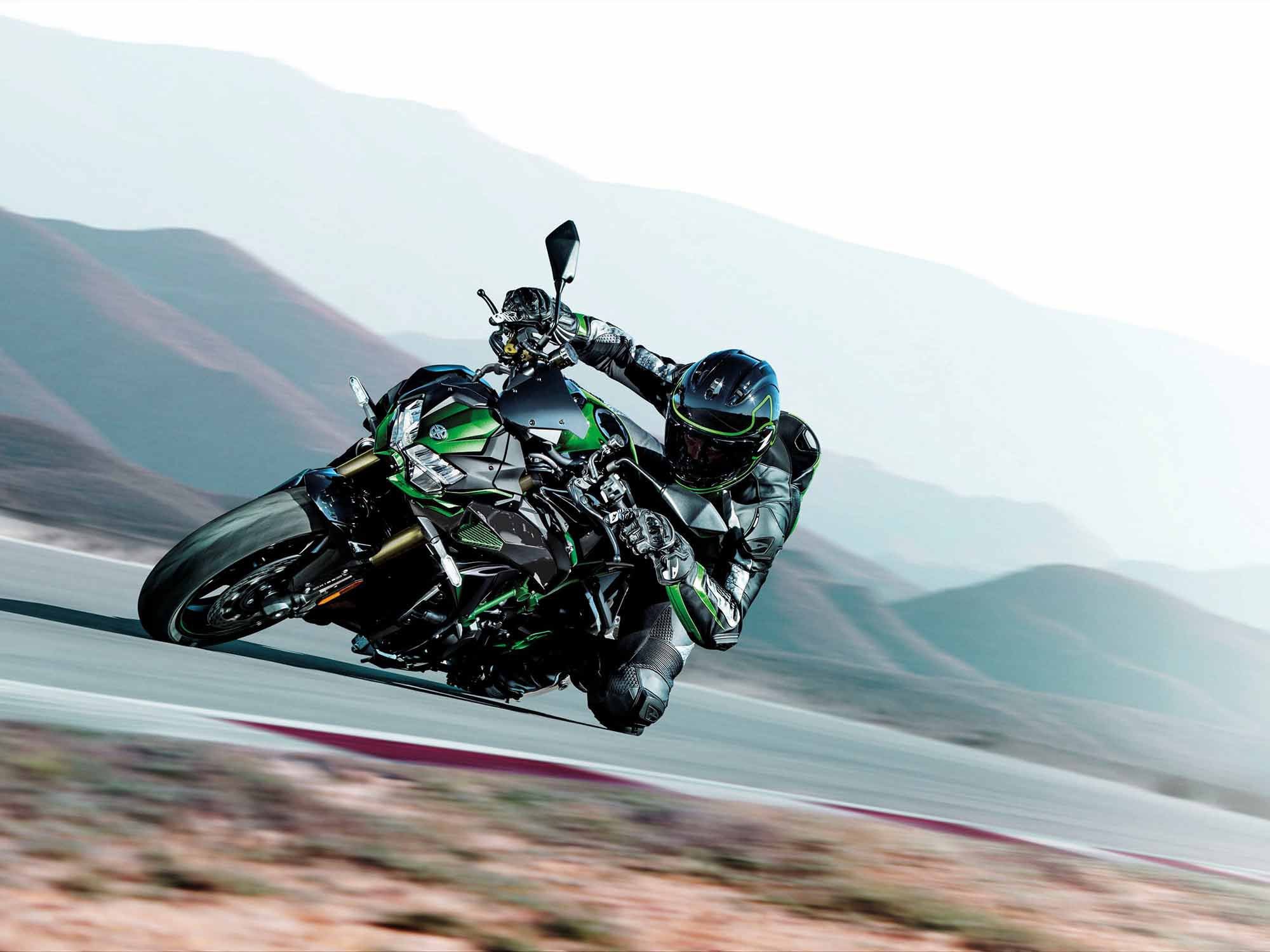
The 2021 Kawasaki Z H2 SE. (Kawasaki /) You’ve gotta hand it to Kawasaki for making the most of its supercharged H2 platform—and for, well, supercharging a 998cc inline-four in the first place. Having gone to all the trouble of developing that nuclear reactor of a motor for the Ninja H2 and H2R hypersports, Kawasaki figured why not put it in a sport-tourer (the Ninja H2 SX) and a naked bike (the Z H2)? Why not? indeed. Maybe Kawi will put it in a cruiser next. Or a side-by-side. Wishful thinking aside, for 2021, last year’s Z H2 debutante will come in SE guise, featuring Kawasaki Electronic Control Suspension (KECS), incorporating Showa Skyhook technology.
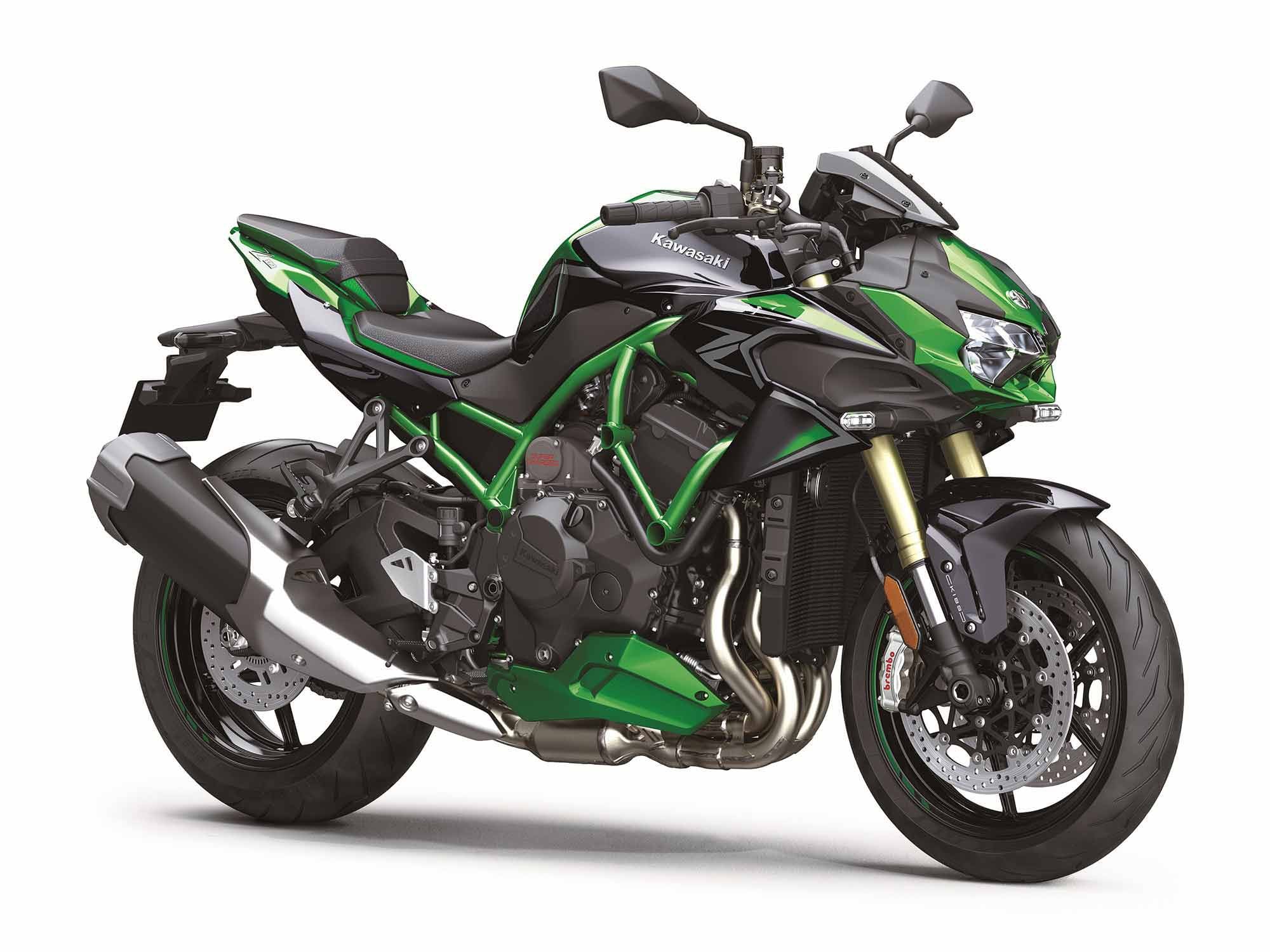
I’ve seen Buicks with smaller radiators. With great power comes great heat. (Kawasaki/) The technology, the original version of which debuted on Ducati’s Multistrada in 2013, differs from other semi-active systems by aiming to maintain the motorcycle’s vertical position relative to the road for a smooth ride, while reducing pitching under deceleration—thus creating the “suspended from the sky” feeling. Kawasaki fine-tuned the system for implementation on the Z H2 SE. The system gathers information about suspension stroke speed, positive and negative acceleration, wheel speed, and front braking pressure—and takes into account vertical acceleration and pitch rate—before adjusting damping via a solenoid valve that can react in as little as one millisecond.
Damping quality—what riders would describe using the shorthand “soft” or “firm”—corresponds to the selected ride mode (Sport, Road, Rain, Manual). The system also includes electronically adjustable rear preload.
The press release mentions that one of Skyhook’s major benefits is that it reduces pitching during two-up riding. While one can foresee some light two-up touring on the H2 SX, it’s gotta be said, if your significant other is willing to sit on the back of a 200-hp, supercharged hyper naked, you may be dating/married to a lunatic. Just a heads-up.
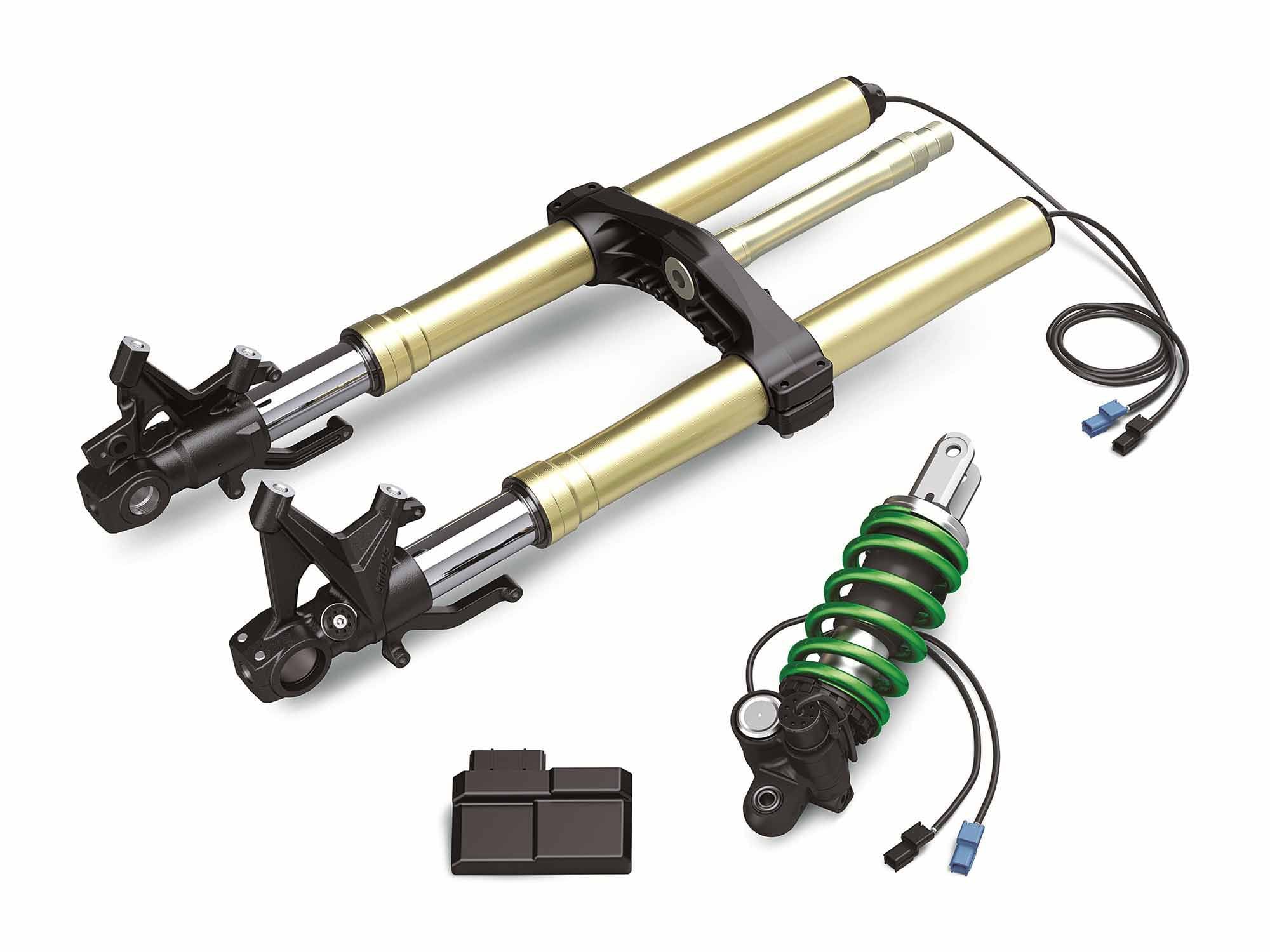
The hardware in question. (Kawasaki /) The Z H2 SE also features high-end Brembo Stylema calipers, replacing the standard Z H2′s Brembo M4.32 calipers, that bite 320mm discs up front and a 250mm disc in the rear.
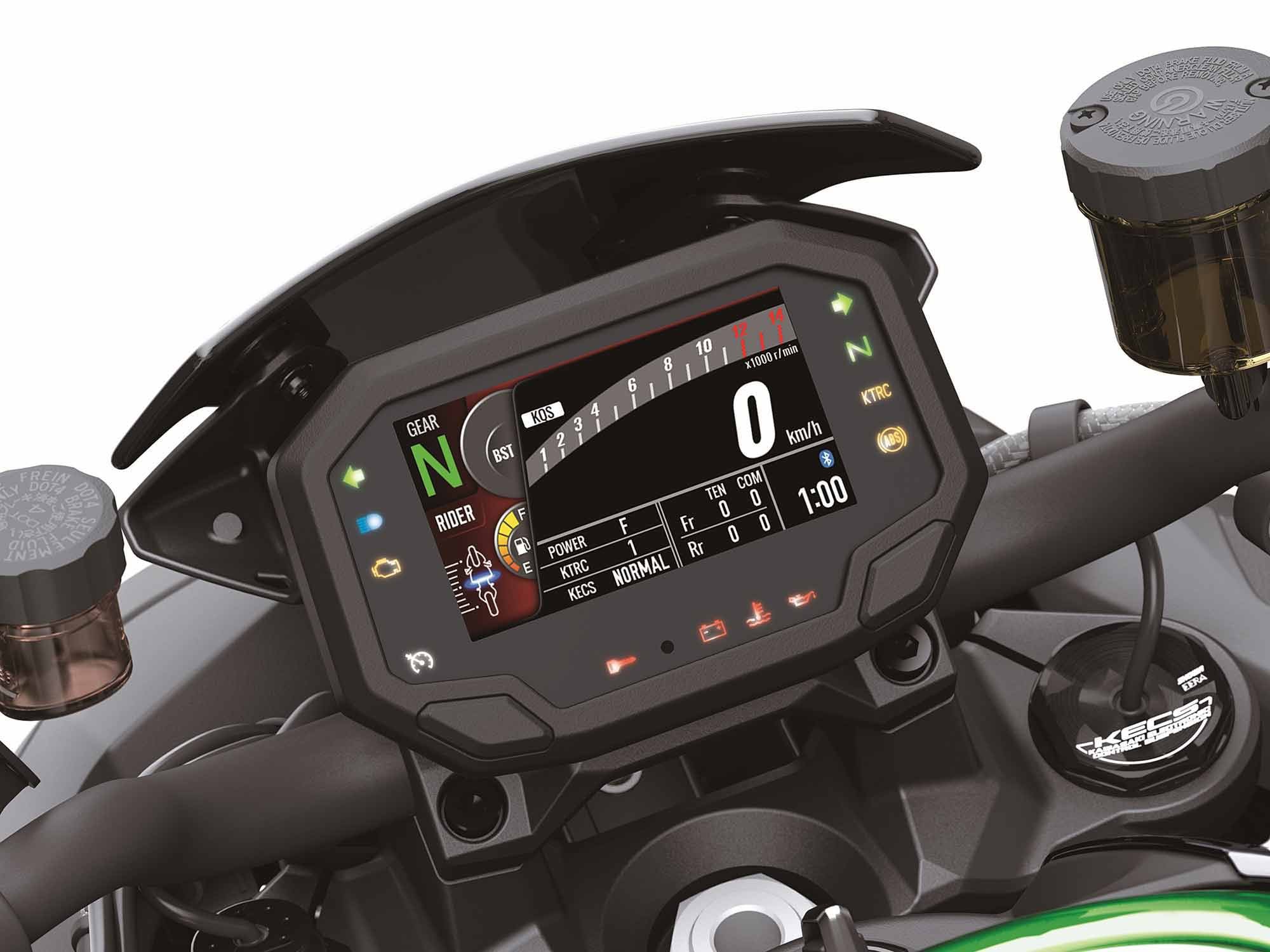
A TFT dash displays all necessary info. (Kawasaki /) In all other respects, the SE is the same sledgehammer as the standard Z H2—not that a supercharged Ninja with 200-ish hp (claimed) can ever rightly be called “standard.” What I mean is, the SE gets the same goodies: TFT dash, up-to-the-minute rider aids, quickshifter, cruise control, slip-assist clutch, smartphone connectivity, etc.
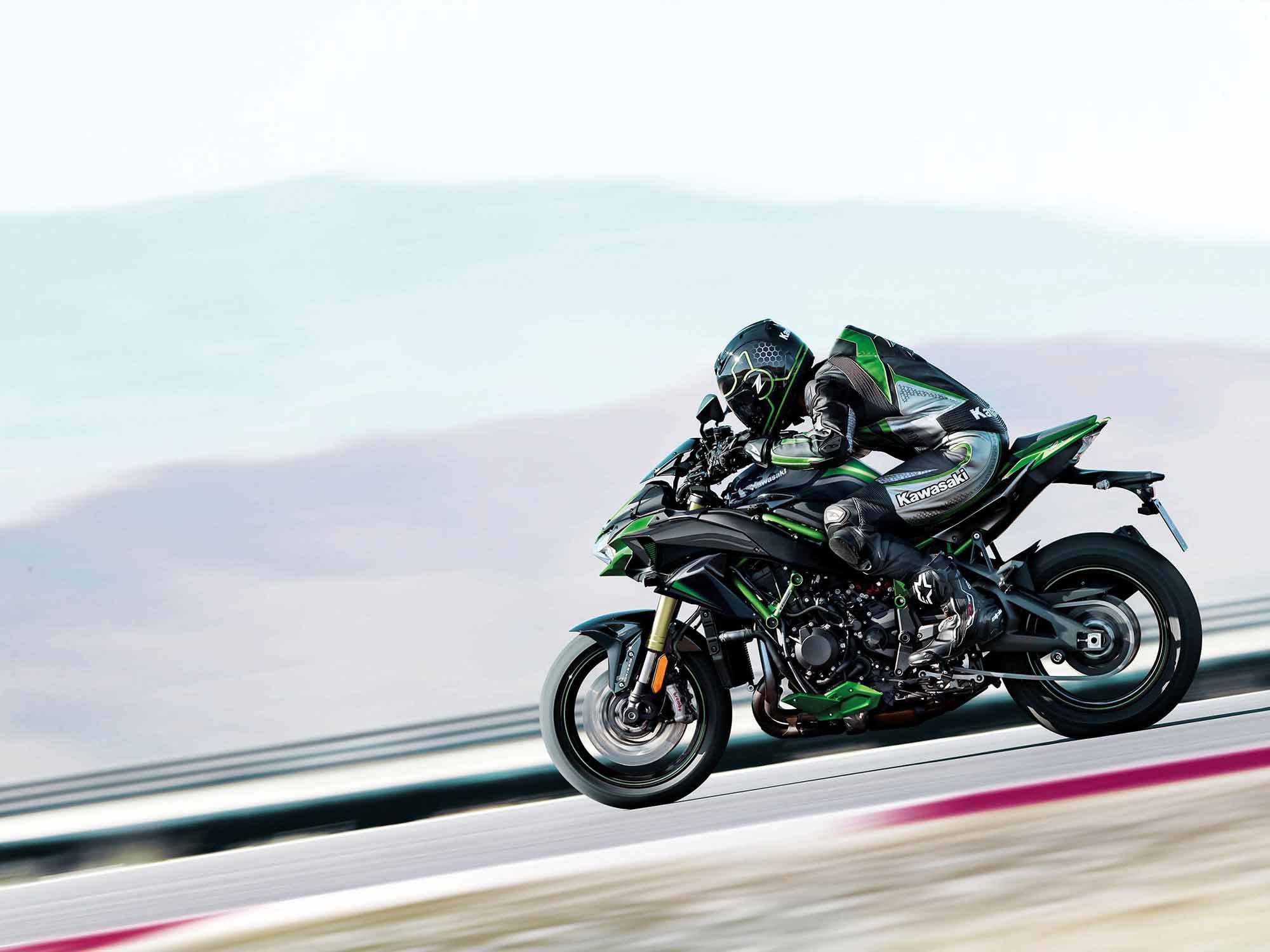
Ready for takeoff. (Kawasaki/) The 2021 Z H2 SE is available in Golden Blazed Green/Metallic Diablo Black for $19,700. That’s $2,200 more than the base model Z H2.
-
Adventure bikes are the conquerors of just about all of the land the sunlight touches, but up until recently they were large, tanks of machines built for more experienced riders. Beginners like to explore too. Honda’s CB500X was first introduced in 2013 as a means to hit the more urban side of the adventure category and fill a void that larger-displacement ADVs left unconquered. And now, to the enjoyment of newer riders, just about every displacement level is represented in the ADV category with the Honda CB500X laying claim to the small parallel-twin realm.
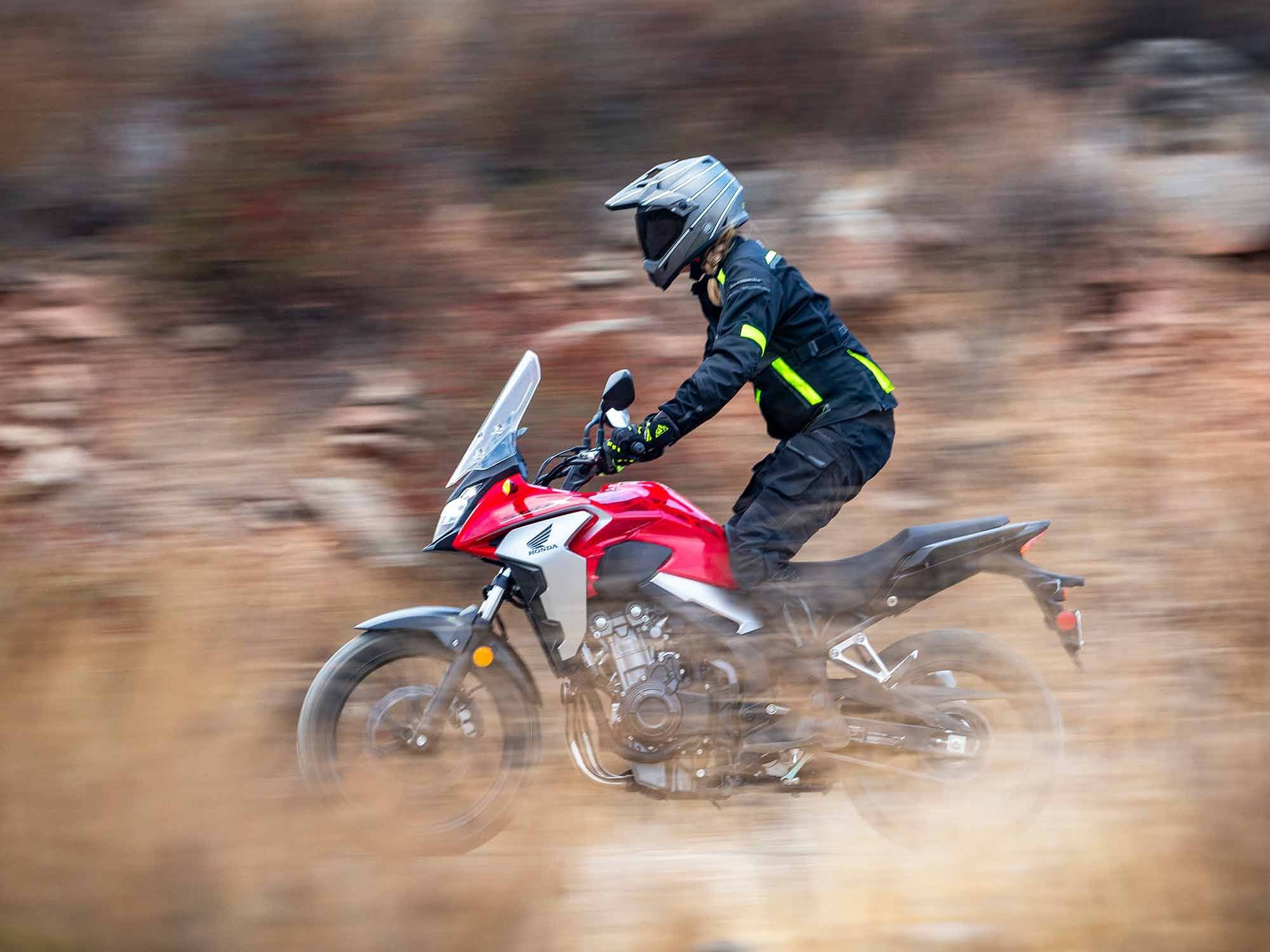
The 2020 Honda CB500X makes adventuring possible for the common commuter. (Jeff Allen /) As you may recall from our 2019 review, this motorcycle started out as a midsize commuter. Owners were adventure-fying it with modifications to the suspension and swapping to knobby tires. Honda noticed and last year gave it an adventure-focused makeover that we see today.
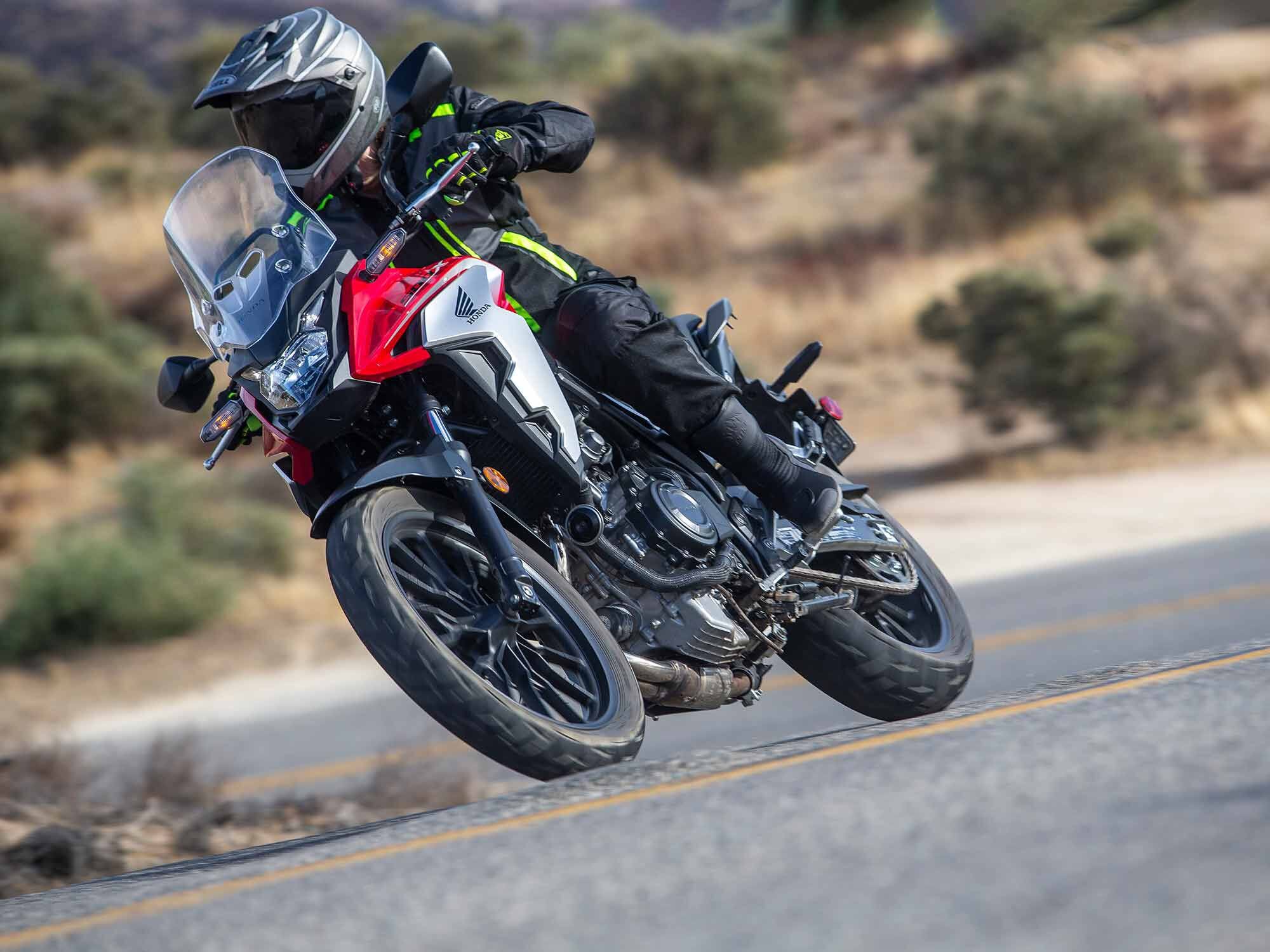
On road the CB500X flaunts its commuting roots. (Jeff Allen /) The first thing you will notice when twisting the throttle is the CB-X’s smooth transmission and a mild-mannered 471cc parallel-twin engine. The clutch pull is light and modulation is easy thanks to the slipper assist function—a perk for navigating the daily stop-and-go. While the gear changes are nice and smooth, downshifting between first and second does occasionally catch on neutral. The engine, although docile, was in no way lacking when it came to the spirited paces of Southern California’s busiest freeways. Its 42.45 hp at 8,130 rpm and 29.25 pound-feet at 6,500 rpm recorded during a fourth-gear pull on the CW in-house dyno are plenty for an adventure motorcycle meant to be friendly and usable.
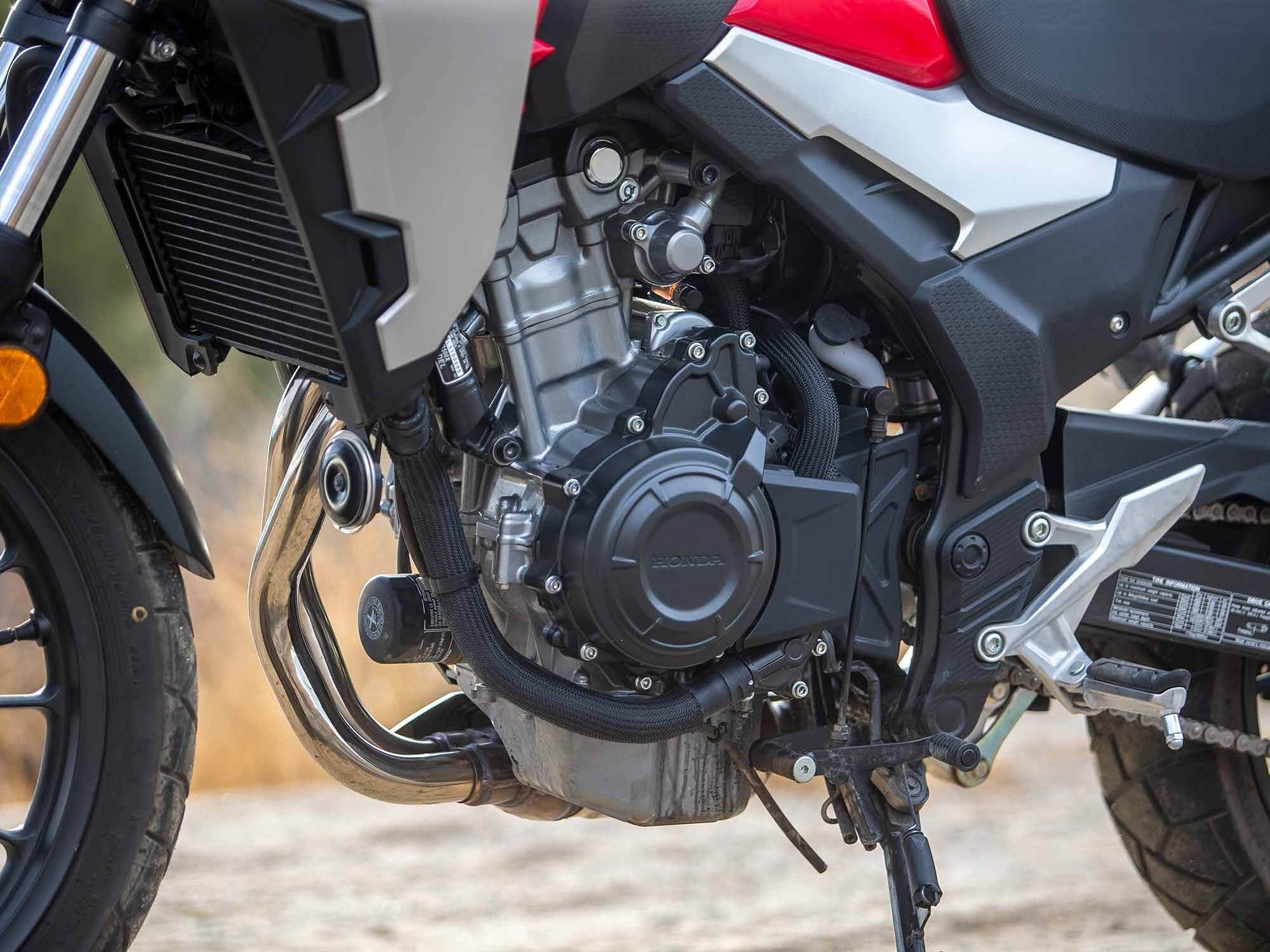
The 471cc parallel twin is a very smooth deliverer of power and is suitable for any type of rider or riding. ( Jeff Allen/) Vibration is well tamed until the machine is revved to about 7,0008,000 rpm—only a faint buzz is felt through the seat at and above that point. When cruising along at speed the windscreen serves its purpose in deflecting the wind, but you best be sure the placement is suitable before your journey because the two-height adjustability does require tools. When wearing an ADV-style helmet I did notice the wind buffeting the visor when hitting freeway speeds, nothing a little more tuck behind won’t fix.
RELATED: 2019 Honda CB500X First Ride Review
Another commuter-friendly benefit of this machine is that it sips fuel from its 4.6-gallon fuel tank. With an average of 54.6 mpg recorded, in the best case scenario of economical riding, roughly 251 miles can be had per tank.
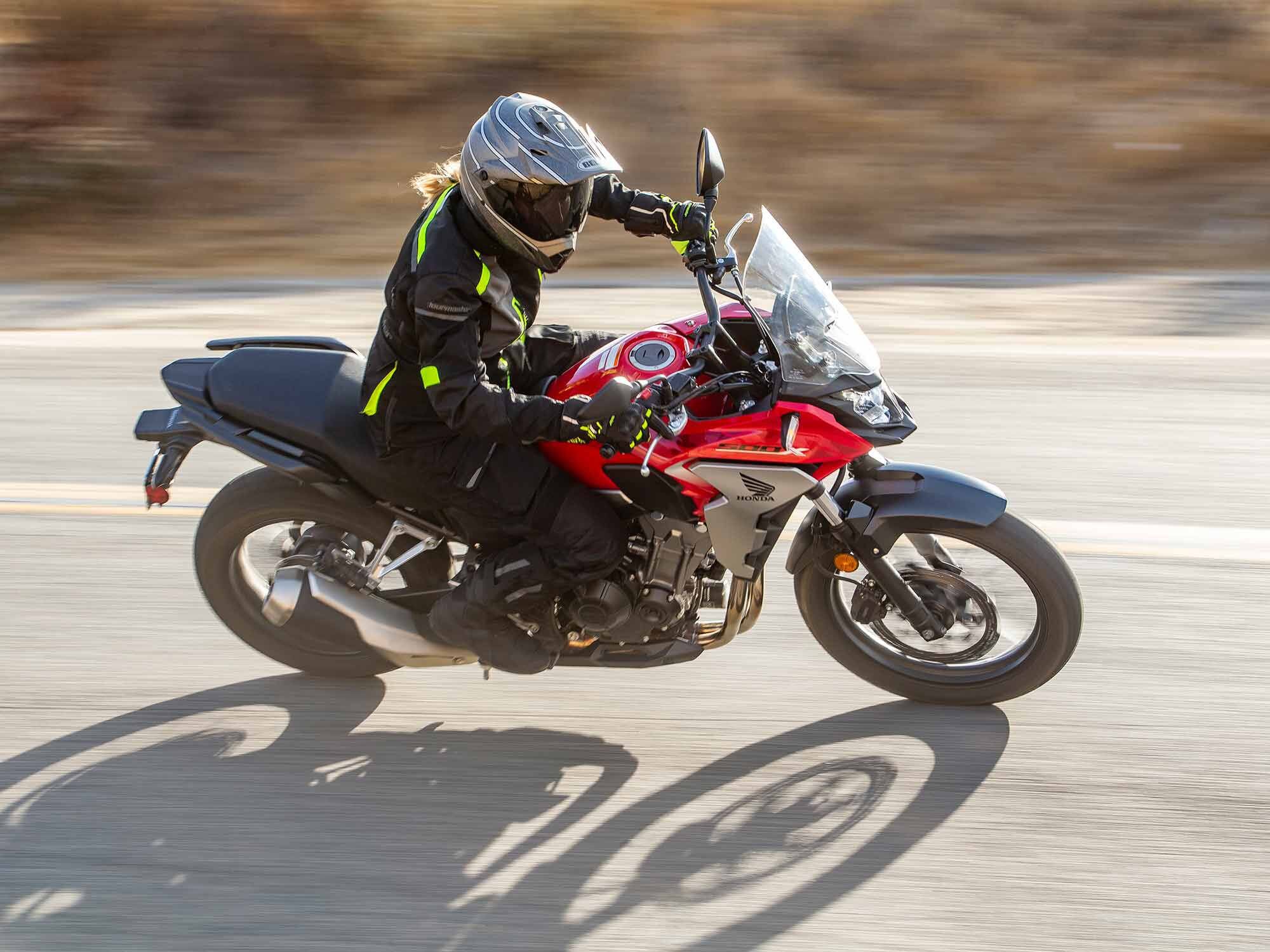
The CB500X’s fuel efficiency is very impressive. (Jeff Allen /) On the pavement, the CB-X’s 41mm telescopic fork and single shock are soft and don’t allow for a planted feel in switchbacks—mid-turn bumps have the rear pogoing over those undulations, causing instability. The rear’s setup only allows for preload adjustability, which will not help tame the rear end’s undulations. Suspension at a price comes with some compromises. The combination of the softer suspension and 19-inch front wheel suits the dirt roads well though. Washboard bumps and jagged ruts are soaked up without much issue, and the blows are softened without jarring to the rider, even when the 5.9 inches of front-end travel was bottomed out on larger obstacles.

The soft suspension does provide more comfort in the dirt, though it is not as stiff as preferred for tackling twisties on the pavement. ( Jeff Allen/) The chunky block Dunlop Trailmax Mixtour tires that wrap around 19- and 17-inch cast aluminum rims provide a blend of both paved and dirt road capability. The tires stick well to the asphalt and offer commendable grip on fire road surfaces. There is, however, a bias toward harder-packed dirt over gravel since the rear tire struggles to find forward drive in deep gravel.
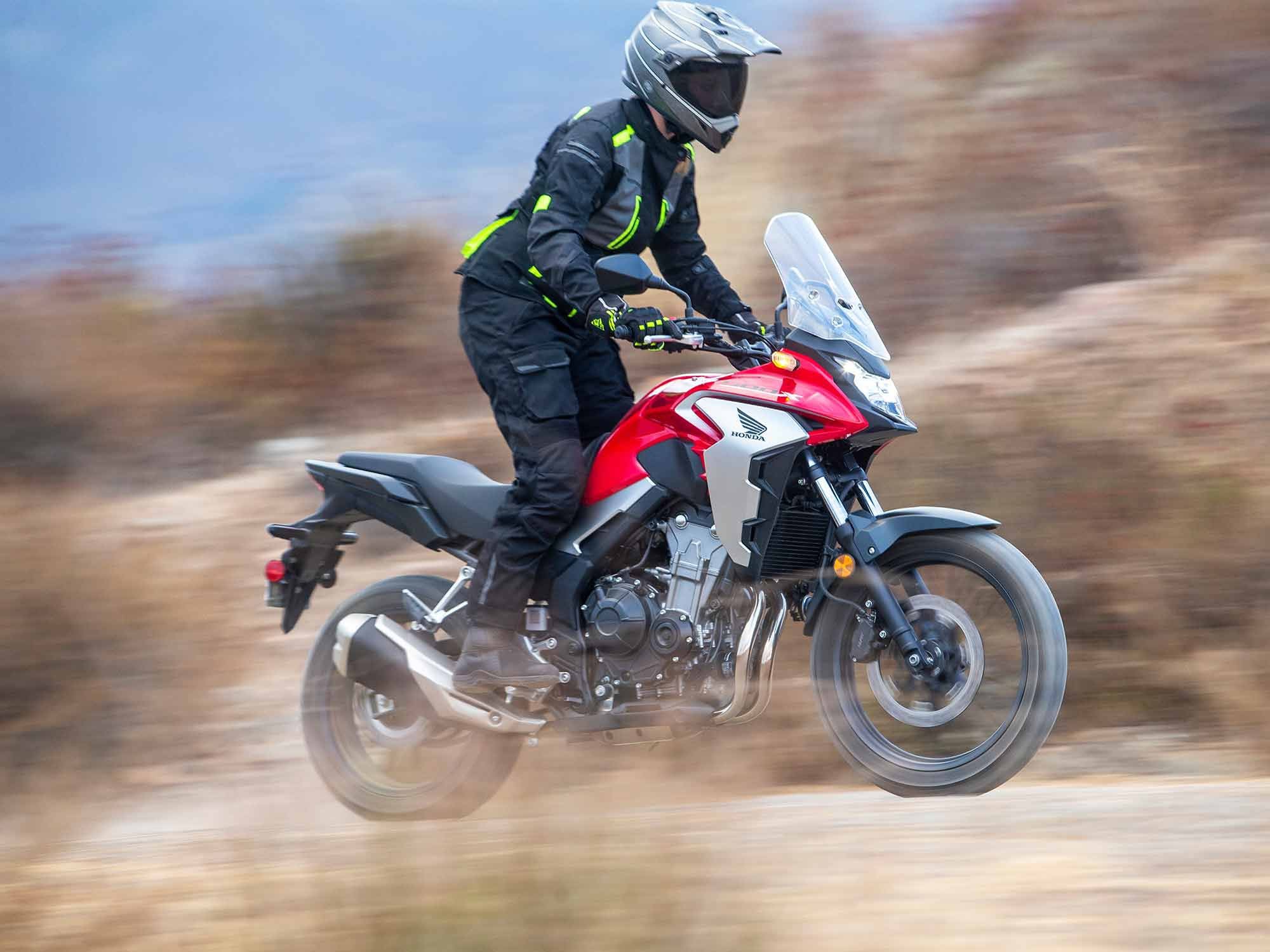
The rider triangle is a comfortable one. Standing up, however, does present a few flaws. (Jeff Allen /) Seat height is 32.7 inches but it feels a little taller than that with the seat’s somewhat boxy spread between the legs. While I had no issue with flat-footing, riders with shorter inseams will be on their toes. Commuting to and from the office or around town is done in comfort; the ergonomics are upright with the tapered handlebar and central peg position. The width of the bar and low-slung CW-measured 431-pound weight allow for easy slow-speed maneuvering. Standing up on the pegs for dirt sections was only fairly comfortable since the bars were just a tad low and back causing me to bend more over the bars than preferred while intruding on my knee space. With the balls of my size 10 feet situated on the pegs my right heel rested on the exhaust cover when in a standing position as well, further cramping the rider’s space. Another tight area was the mirror height above the grips—the stubby mounts don’t give a lot of space above the grips, something that was most noticeable when in a standing position or when replacing hands to the grips.
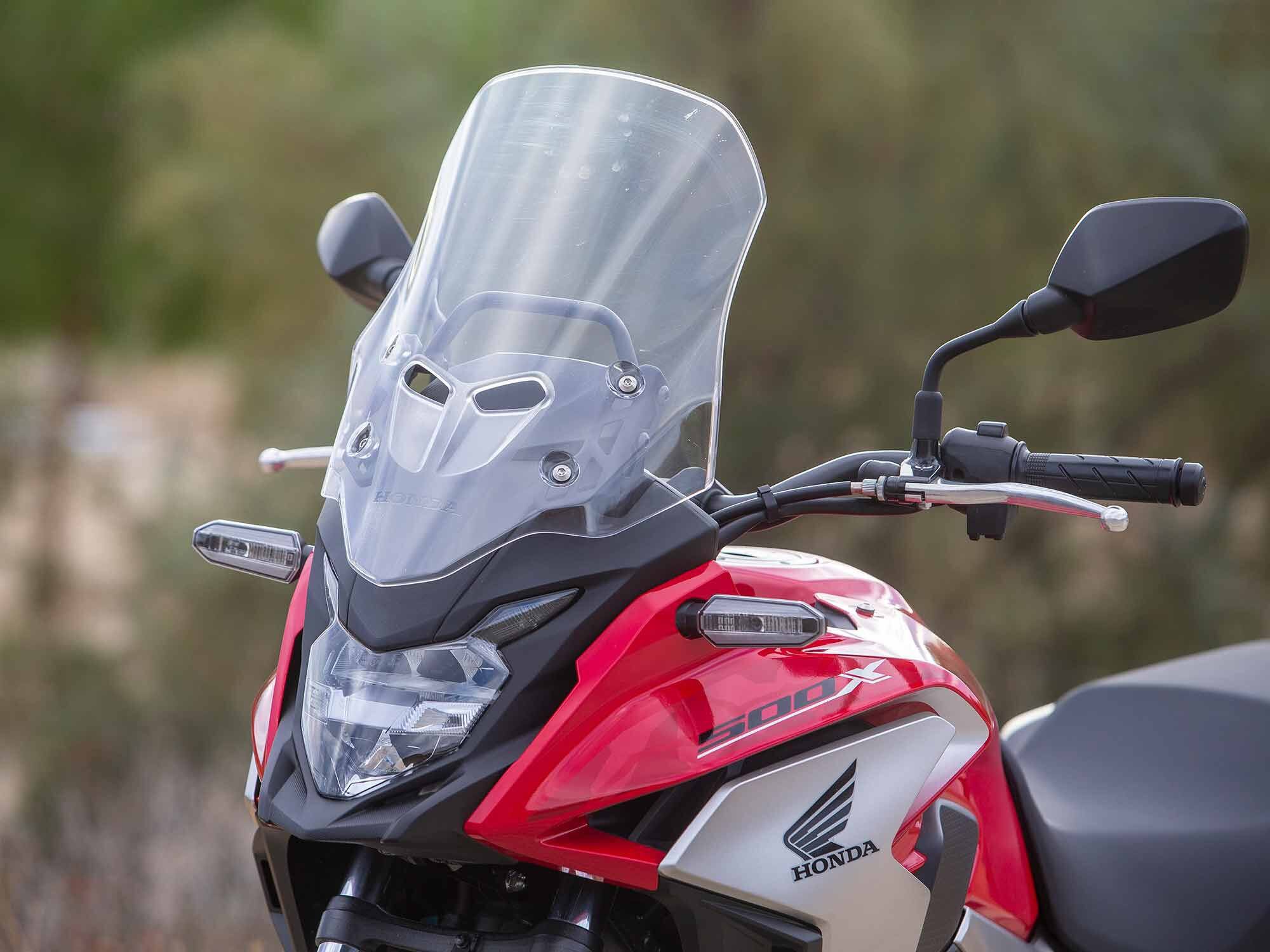
The windshield provides added comfort for the commute, however, giving the mirrors a fist pump is a fairly common occurrence when putting your hands back on the grips at a stoplight. (Jeff Allen /) 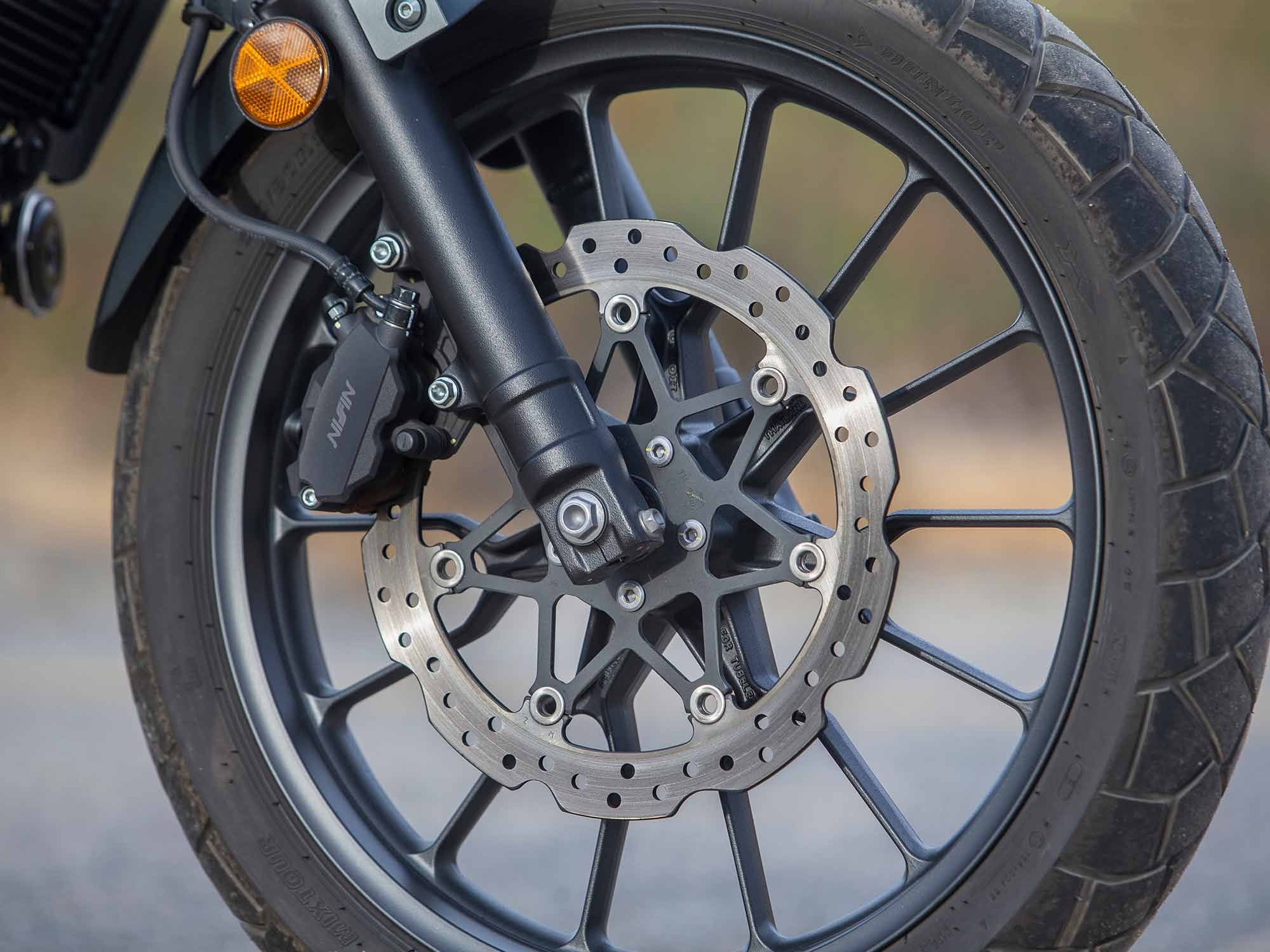
Both the front and rear brakes are not noticeably aggressive, but they do sufficiently bring the bike to a stop without drama. ( Jeff Allen/) With a single finger pull at the brake lever, the front’s single Nissin two-piston caliper offers decent grip on the 320mm rotor, but not an overly aggressive one—a positive for less experienced dirt riders. The single Nissin one-piston caliper out back offers a controlled and communicative pressure to the 240mm disc as well. In short, no criticisms are warranted—they simply get the job done without drama. Our test unit was the non-ABS version; ABS is available for a $300 upcharge.
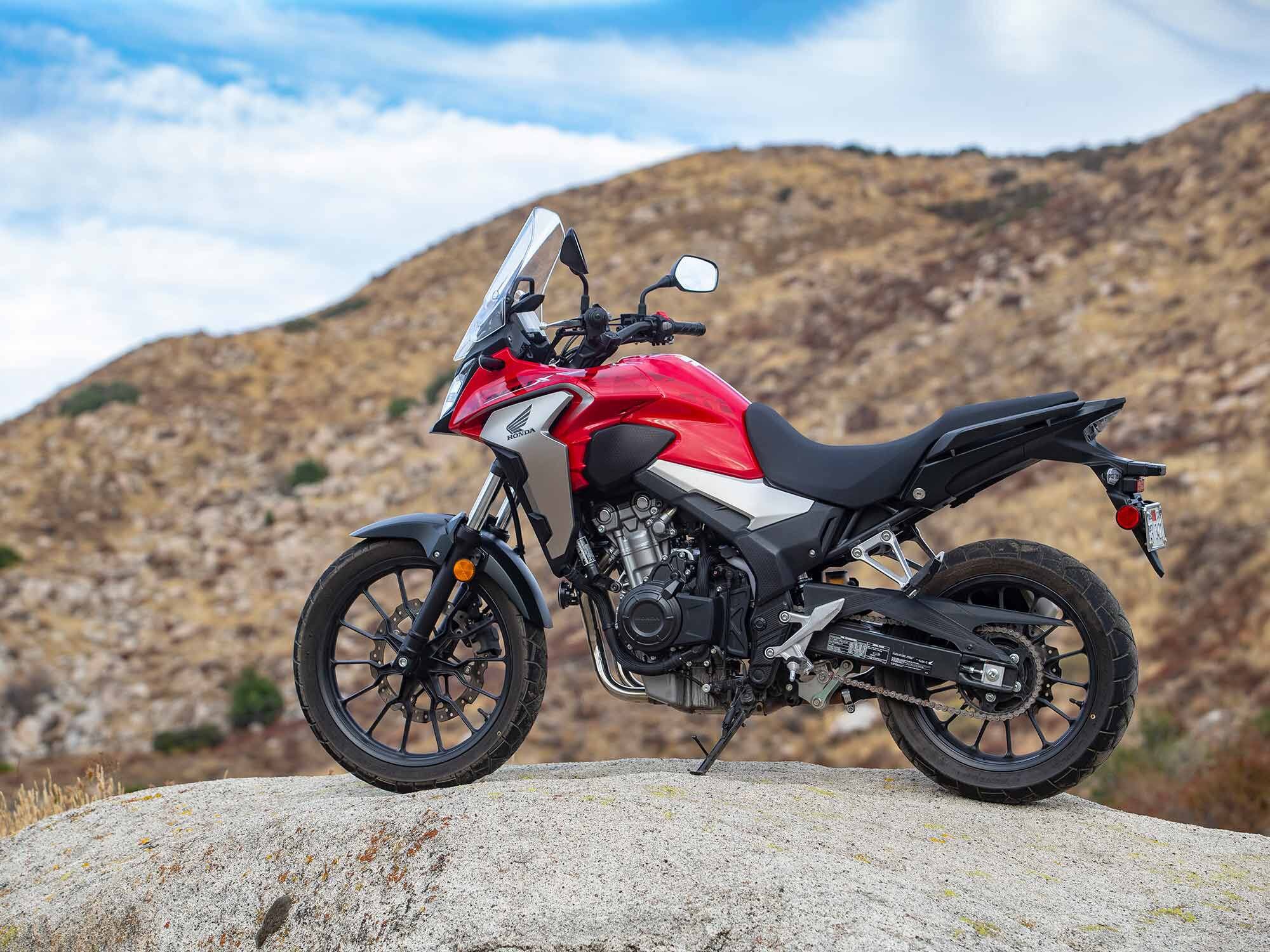
The profile hints at adventure. (Jeff Allen/) Not only does the suspension and large chunky-block tires hint to its ADV designation intent, the slight ADV-like beak protrudes from beneath an LED headlight to further the ADV story. LED blinkers also offer a clean and polished look that is so prevalent on the latest Hondas. A light bar, hand guards, and pannier sets are also available as accessories to make this machine more suited for longer, more rugged journeys.
RELATED: 2019 Honda CB500X vs. Kawasaki Versys-X 300
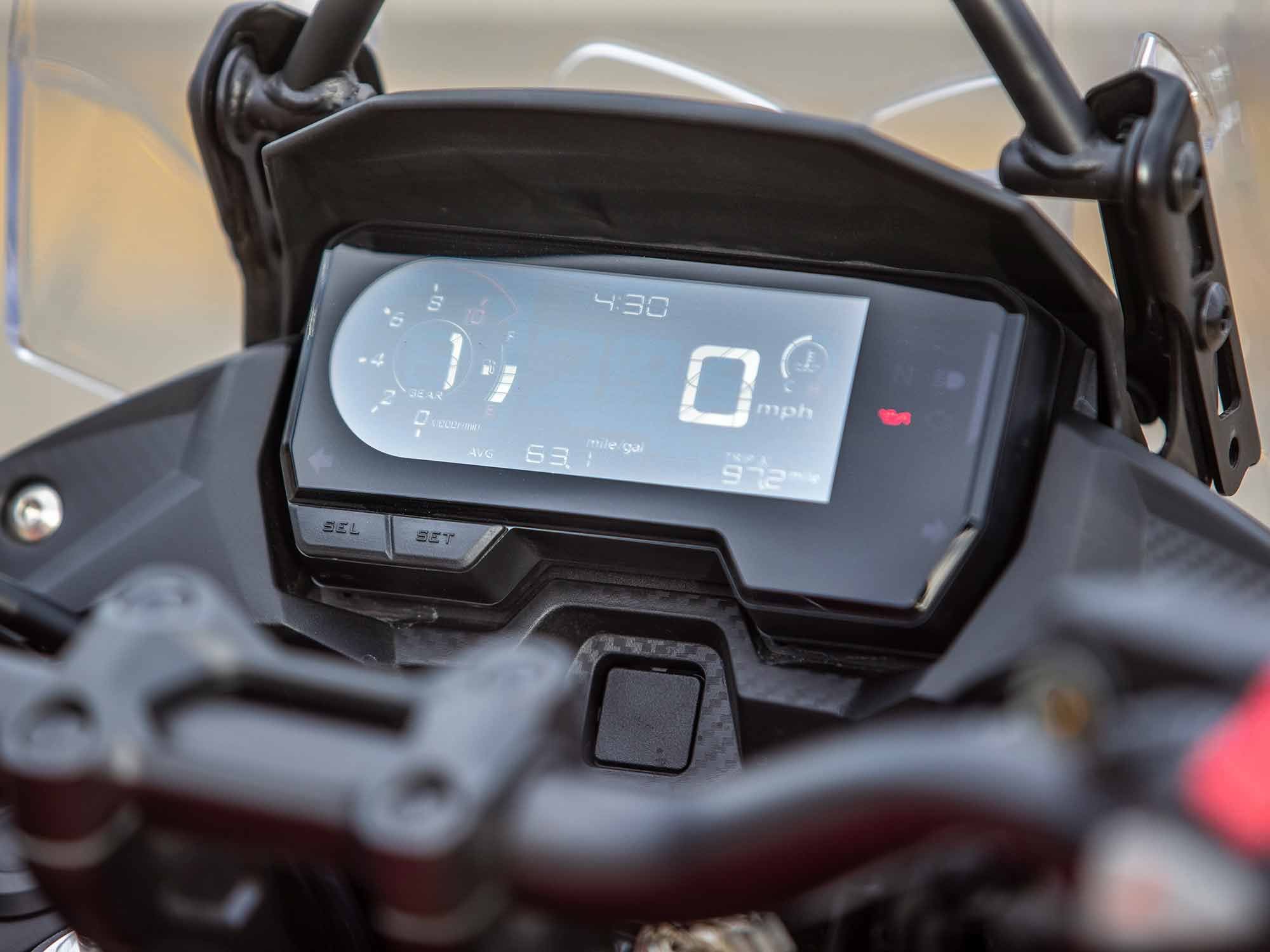
The gauge is easy to read. There is a second digital tachometer located in the bottom right toggle menu which seems redundant considering the larger circular one on the left. (Jeff Allen/) Finally, the LCD display provides easily discernible figures for the gear position, speed, clock, toggle menus, and a circular tachometer, but what left me a bit confused was the redundancy of tachometers—a larger circular one on the left and a digital one in the bottom right toggle menu. Regardless, you will be well informed of how quickly that crankshaft is spinning.
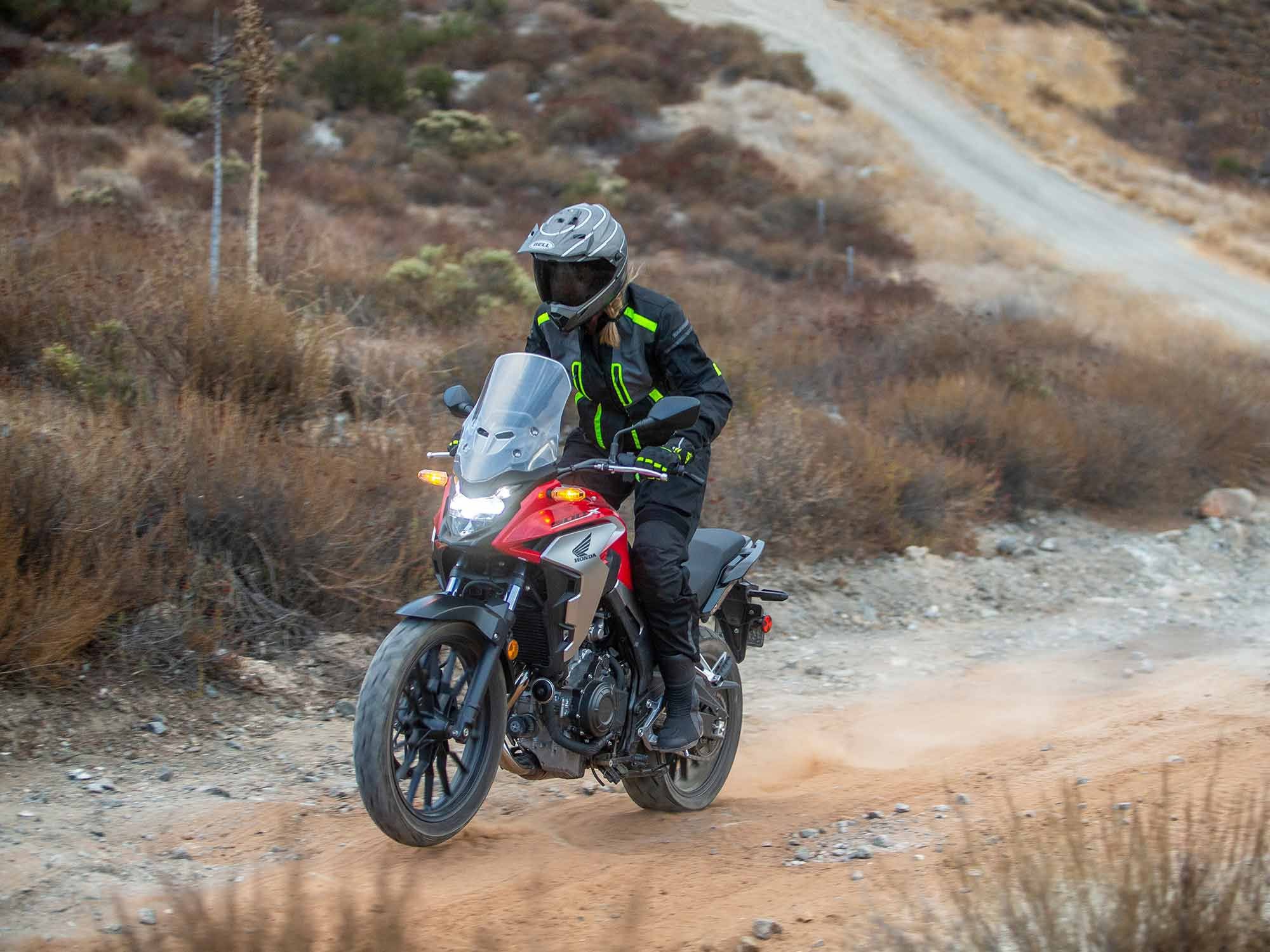
Commute? Absolutely. Dirt? Sure! ( Jeff Allen/) The CB500X’s appeal is its lighter, more beginner-friendly approach to the ADV class and while it does have a commuter background, it can handle a bit of off-road. So go ahead and have fun on the dirt on weekends and then ride it down the freeway to your 9–5 the rest of the days of the week. It’ll take it.
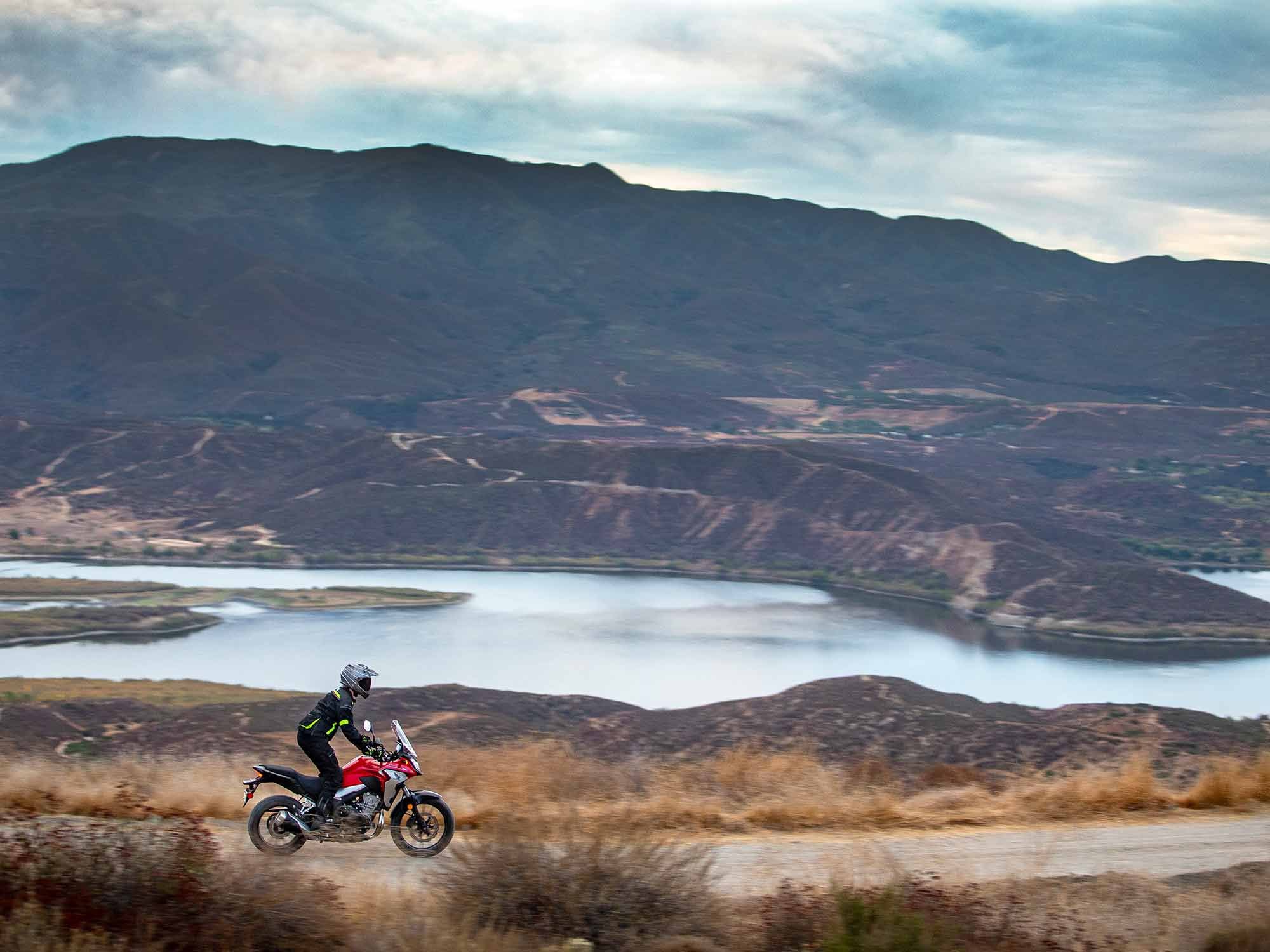
Go ahead and explore a little. (Jeff Allen /) 2020 Honda CB500X Specifications
MSRP: $6,699 (non-ABS)/$6,999 (ABS) Engine: 471cc, DOHC, liquid-cooled parallel-twin Bore x Stroke: 67.0 x 66.8mm Transmission/Final Drive: 6-speed/chain Cycle World Measured Horsepower: 42.45 hp @ 8,130 rpm Cycle World Measured Torque: 29.25 lb.-ft. @ 6,500 rpm Fuel System: PGM-FI w/ 34mm throttle bodies Clutch: Wet, multiplate Engine Management/Ignition: Computer-controlled digital transistorized w/ electronic advance Frame: Diamond-type frame Front Suspension: 41mm telescopic fork; 5.9 in.-travel Rear Suspension: Pro-Link single shock adjustable for spring preload; 5.9-in. travel Front Brake: 2-piston caliper, 320mm petal-style disc Rear Brake: 1-piston caliper, 240mm petal-style disc Tires, Front/Rear: 110/80-19 / 160/60-17 Rake/Trail: 27.5º/4.3 in. Wheelbase: 56.9 in. Ground Clearance: 7.1 in. Seat Height: 32.7 in. Fuel Capacity: 4.6 gal. Cycle World Measured Wet Weight: 431 lb. Availability: Now Contact: powersports.honda.com GEARBOX

Smooth-going comfort and exploratory fun. (Jeff Allen /) Helmet: Bell MX-9 Adventure
Jacket: Tourmaster Transition Jacket
Pant: Tourmaster Caliber Pant
Gloves: Tourmaster Super Tour Gloves
Boots: Tourmaster Solution WP Boot
-
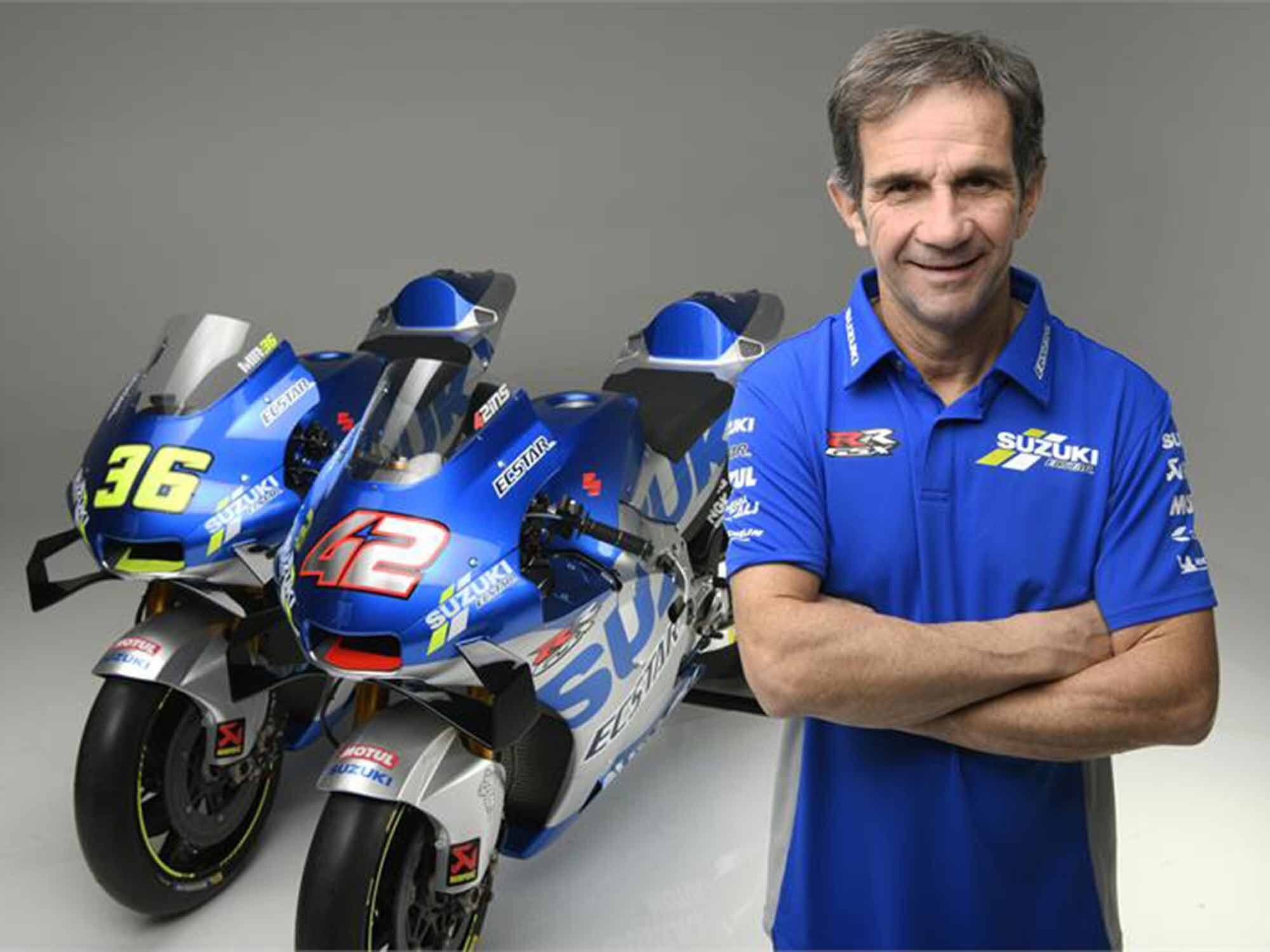
Davide Brivio has led Suzuki’s MotoGP effort since its return to racing. (Suzuki Racing/) “I don’t teach football aces to play. I coach teams.” This famous quote from Premier League legend José Mourinho, one of the most decorated football managers of all time, perfectly describes the approach of Davide Brivio, the man behind 2020′s potential triple crown winners. Now that he has helped guide Joan Mir to claim the 2020 World Championship at Valencia and helmed Team Suzuki Ecstar’s team championship effort, Brivio’s near-miss of the constructor’s championship demonstrates how far he has brought the Suzuki MotoGP effort.
We spoke with Brivio to discover what it takes to be a team manager and how Suzuki has gone from the returning new kids on the block to world champions. Watching Brivio’s tears of joy in the Suzuki garage as Mir crossed the finish line at Valencia, many MotoGP fans’ first thoughts were that “he did it again”; Brivio, after all, was behind Yamaha’s return to victory with Valentino Rossi in 2004. That he is the man behind Suzuki’s success in only the sixth season of its comeback in MotoGP—and during the 100th anniversary of the company, no less—is a simply perfect story.
As you often confess, the Suzuki project started from a white page. So how did you start?
I come from an area, the Brianza (not far from Milan), where all my friends and schoolmates played football. I loved motorcycle racing instead, especially motocross, and I dreamed of becoming a racer one day. I had no budget, but this didn’t prevent me from reading all the sports newspapers and following the races. I was passionate about motocross, and the Gilera factory was very close by. So when I was 14 years old I volunteered myself for the position of a mechanic, or assistant mechanic, for free. Nowadays, if I got a letter like this, I would laugh.
I did some motocross racing, but I was not fast enough. Once I realized I had no future as a racer, I had to reinvent myself. I started to follow motocross races as a reporter and then as a press officer in WSBK with Fabrizio Pirovano. It was not my ideal job, but for me it was a dream come true to walk in a paddock. I have been in World SBK for 11 years. In 2000, we came very close to winning the title with Noriyuki Haga and Yamaha, but ultimately Colin Edwards won and the following year I followed Haga to MotoGP. In 2002, I was with Marlboro’s Yamaha team, with Max Biaggi and Carlos Checa.
Which lesson did you learn from this first start?
That you have to be humble and pursue your dreams and skills. I started with positions that didn’t suit me perfectly, but they helped me to better understand our sport. I then became team coordinator, team manager, but I considered myself always “in progress.” I was observing, listening, and learning from the most experienced people around me, like Fiorenzo Fanali, for example, as he had been the mechanic of Giacomo Agostini and Eddie Lawson.… He helped me a lot. I used to read sports magazines, so for me the references were Kenny Roberts or Agostini running their teams.
How did you end up at the head of Rossi’s team?
In 2002, I joined Yamaha as team director with Lin Jarvis, who was managing director. Biaggi and Checa were our riders, but in summer 2002 Yamaha decided not to renew Biaggi’s contract. Marco Melandri replaced him in 2003, but it was a very difficult year. We didn’t score any podiums, except for Yamaha’s satellite rider Alex Barros in Le Mans on the wet. We needed to reorganize the team, especially because the 2005 season would be Yamaha’s 50th anniversary, so we wanted to do something big. The name Valentino Rossi came up, but it was a bit controversial. The majority thought it was a crazy idea. Why should he leave Honda for us, considering that we hadn’t been winning for the past 12 years? [Yamaha MotoGP head] Masao Furusawa made a big push to hire Valentino, and the duo of Rossi and Furusawa wrote Yamaha history. We won four titles together (in 2004, 2005, 2008, and 2009).
What did you learn from Rossi?
The winning mentality. When Valentino joined Yamaha, he taught us the winning approach—the necessary switch from winning a race to winning a championship.
Is this winning mindset what you brought to Suzuki?
Suzuki has a long tradition in racing. When I joined the company I brought this experience, but also my expertise in working with a Japanese company. We did it all together with their support. But the good thing is that they always followed up.
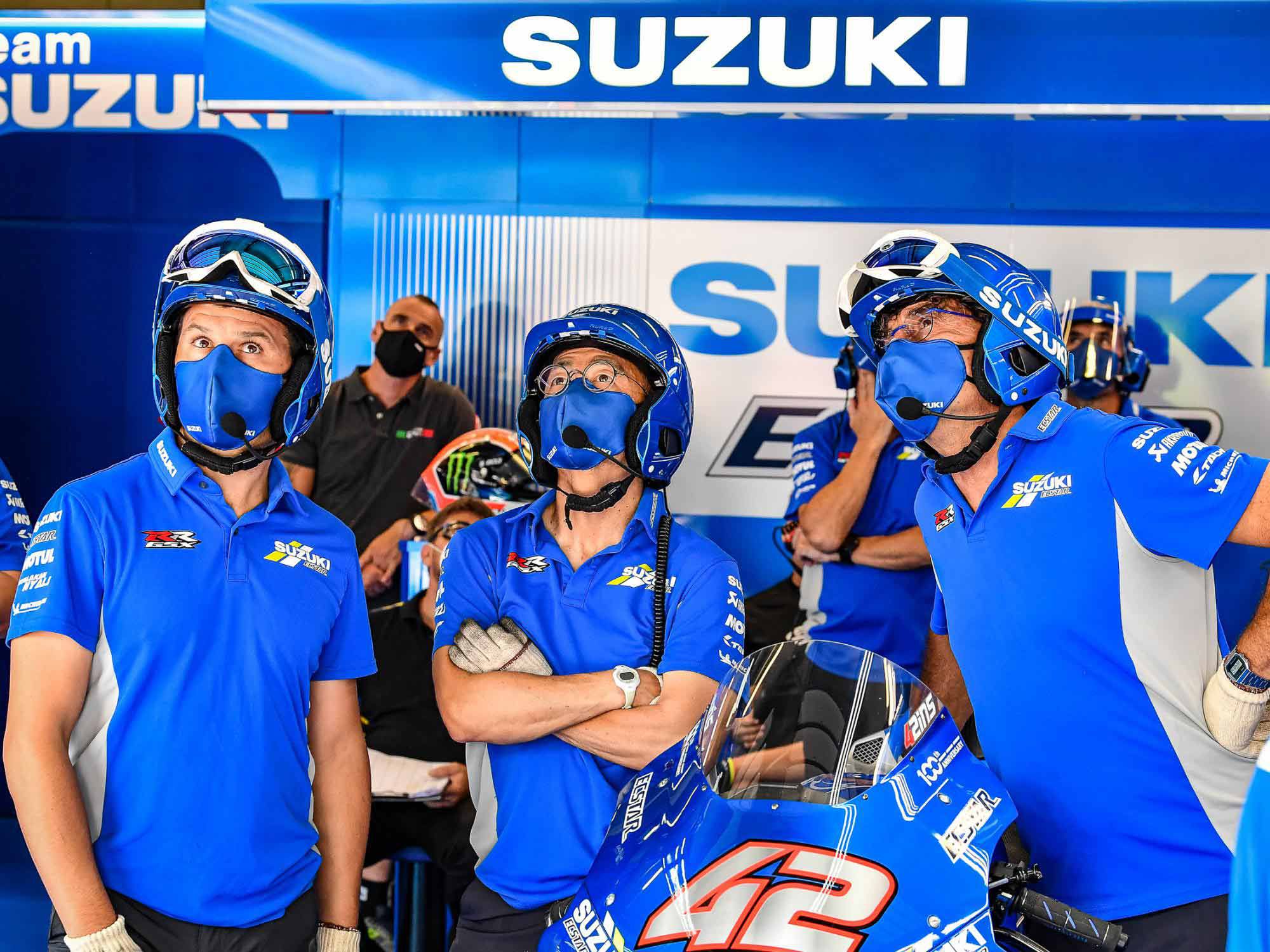
Brivio has assembled a team that is motivated and all-in on Suzuki. (MotoGP /) What was the atmosphere at Suzuki when you joined the team? Were they different from the Japanese engineers you knew from Yamaha?
When I joined Suzuki, I found the atmosphere I had found in Yamaha 15 to 20 years before: They were humble, driven by the desire to win. They wanted to return to MotoGP. They had designed a V-4 engine, but they were thinking of four cylinders inline. As they were projecting the new engine they called me.
I remember one of the first meetings where I asked why Suzuki left MotoGP in 2011, and when I started to talk to them was the end of 2012. I started officially on the 1st of April 2013! At that time I was working with Valentino, managing his things privately, but I was attracted by the project: I was missing the managing side of the work.
What did you like most about the Suzuki project?
With Suzuki, the very nice thing is we really started from a clean sheet of paper. We needed to organize the team from scratch. I remember that I asked, “Where was the base of the team, what about the trucks, the equipment, the crates?” And they said, “We’ve got nothing!” There was no workshop and the trucks and the equipment were not theirs. This made the whole process much more interesting. I will restart tomorrow!
What was the key to hiring the staff?
Suzuki is a big company, in good health, but the budget dedicated to races is less than other manufacturers. This pushed us to be more creative and effective. In hiring people I followed my intuition; I was looking for motivated people who really wanted to be part of the project. This was crucial to build a strong team. I wanted team members driven by ambition, passion, but also down-to-earth and calm, as I am. I always prefer a smile to a punch on a table. The urge to understand the other person and the situation comes first. I don’t like battles and fights when we work together.
Understanding the Japanese mentality was also crucial—they have method, while we Italians have genius, intuition, imagination. Together we are a perfect combination. From my past experience I brought the lesson that you have to listen to everyone. If a mechanic has advice, I’m open to listen and consider his idea. This attitude has built a lot of mutual trust in the team.
What about the rider choice?
As in the team we wanted dedicated technicians happy to join Suzuki—this was the same for the riders. Suzuki had to be their No. 1 priority. This has been crucial for today’s success. Coming from a satellite team, for Aleix Espargaró it was an achievement to join us. The same for rookies Álex Rins and Joan Mir.
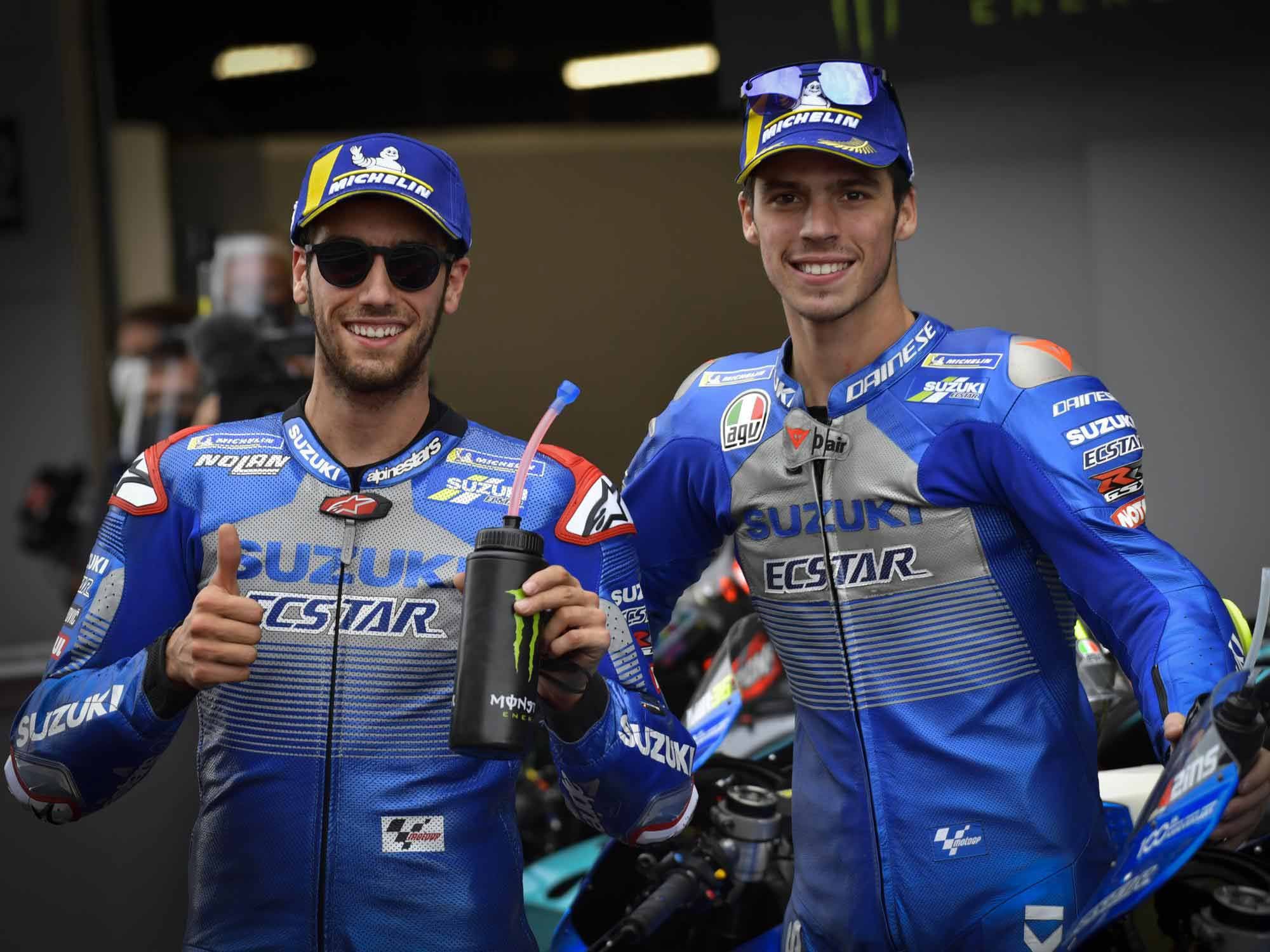
Brivio’s plan of bringing riders up from Moto2 has reaped rewards with Álex Rins and Joan Mir. (MotoGP /) You have a special talent to scout new riders.
We had the intuition to bring in young riders and to grow them up from the beginning, to create a kind of Suzuki rider. Our top management, especially our president, has always encouraged this approach. In a way, it’s much more challenging, but we are also proud of this.
When we started this project there was Maverick Viñales, who we took from Moto2 after only one year in that series. It was a successful choice. When he left for Yamaha, we did the same with Álex (Rins). We saw good results, so we decided to do the same with Joan Mir. Also Joan had only one year’s experience in Moto2, and he was only at his fourth season in the World Championship! Two years in Moto3, one in Moto2, and then jumping into MotoGP. And for Suzuki it’s even more challenging because we don’t have a satellite team; we don’t have a place where we can get young riders, wait for a couple of years to see how they are, and then move them into a factory team. We have to make a bet immediately!
Andrea Dovizioso says that the Suzuki is the most balanced bike.
We don’t have the most powerful engine, even if we had made some progress, but the chassis is excellent. The Suzuki is agile, light, with good handling. And then we have two talented riders because the bike also is not enough.
If there is a term to describe Suzuki’s key to winning, what would you say it is?
I would say, “Simple is better.” There are not too many sophisticated items on our bike. Sometimes our mechanics joke that we have a streetbike, but the point is, the engineers have done well to keep things simple and to introduce only those ideas that were working. The policy has been evolution instead of a revolution.
So what is Brivio’s winning method, and how can you repeat it?
There is no recipe, but I think there have been some crucial factors. Building an extremely motivated team, finding the right understanding between the European and Japanese mentalities to extract the best potential from both sides, investing on young talented riders and growing them in the team as a unique part of the project. Evolving all this together because, in the end, it’s a team achievement. Joan has been incredible, but Álex (Rins) is also part of this success because his support in the development has been essential. This year I would have bet on Rins, but then he got injured and it took a while to recover. Meanwhile Mir’s podium in Austria was a turning point. He made a switch and showed an incredible strong mentality in addition to his consistency and calm, on and off track.
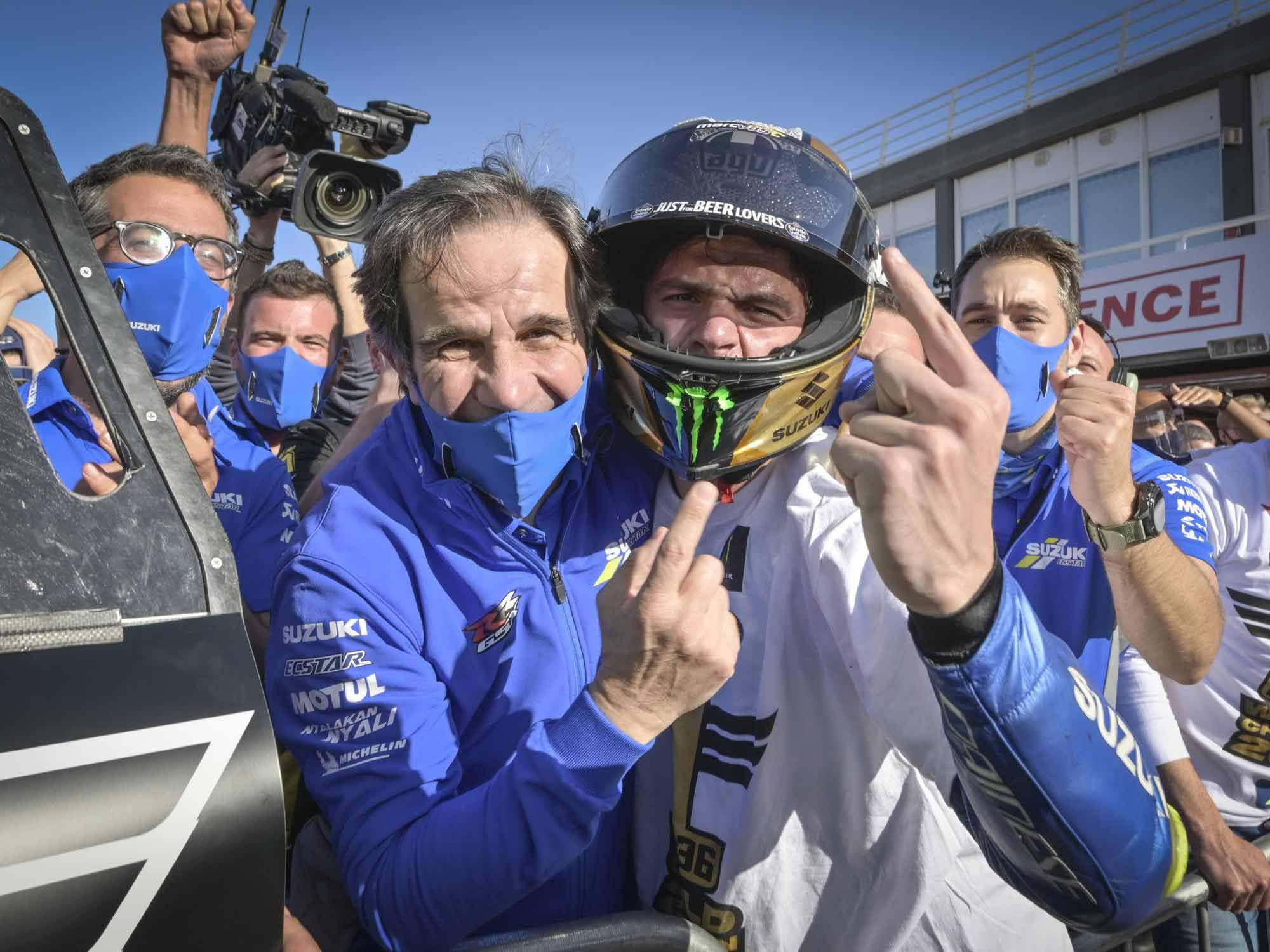
Brivio’s building of an extremely motivated team led to Mir’s 2020 MotoGP Championship. (MotoGP/) This 2020 season was particularly difficult; was there a particularly tough moment?
During the lockdown the preparation continued. What didn’t help us, in a way, were the doubleheaders. We at Suzuki are very fast to find the setup, while our competitors took advantage from returning to the same track, and they grew from one week to another. Apart from that, it was the COVID situation and the uncertainty that made things more difficult.
A season without Marc Márquez was quite special. How do you envision his return in 2021?
I really look forward to it. It would be great to see how these young kids will challenge the big champion. With one more year of experience and more confidence, I would say. I expect a great show.

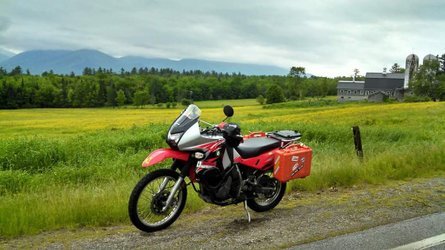
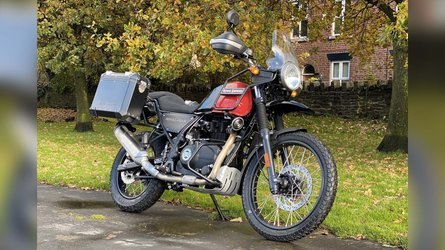
Welcome alex_from_JandS
in Newbies
Posted
Hello alex_from_JandS,
Welcome to The Motorbike forum. Please feel free to browse around and get to know the others. If you have any questions please don't hesitate to ask.
Why not tell us a bit about yourself too.